SolusVM 2 VPS And Cloud For WHMCS
(→About SolusVM 2 VPS & Cloud For WHMCS) |
|||
| (13 intermediate revisions by one user not shown) | |||
| Line 2: | Line 2: | ||
<meta name="keywords" content="solusvm extended vps for whmcs, solusvm extended vps configuration, solusvm extended vps management, solusvm extended vps installation, solusvm extended vps common problems, about solusvm extended vps, solusvm extended vps documentation, solusvm extended vps faq, solusvm extended vps help, solusvm extended vps guide, modulesgarden solusvm extended vps, solusvm extended vps wiki, solusvm extended vps tutorial, solusvm extended vps tips, solusvm extended vps module wiki"></meta> | <meta name="keywords" content="solusvm extended vps for whmcs, solusvm extended vps configuration, solusvm extended vps management, solusvm extended vps installation, solusvm extended vps common problems, about solusvm extended vps, solusvm extended vps documentation, solusvm extended vps faq, solusvm extended vps help, solusvm extended vps guide, modulesgarden solusvm extended vps, solusvm extended vps wiki, solusvm extended vps tutorial, solusvm extended vps tips, solusvm extended vps module wiki"></meta> | ||
<meta name="description" content="ModulesGarden Wiki Contains All The Information You Need About The SolusVM Extended VPS For WHMCS Module."></meta> | <meta name="description" content="ModulesGarden Wiki Contains All The Information You Need About The SolusVM Extended VPS For WHMCS Module."></meta> | ||
| − | |||
| − | |||
| − | |||
| − | |||
=About [https://www.modulesgarden.com/products/whmcs/solusvm-2-vps-and-cloud SolusVM 2 VPS & Cloud For WHMCS] = | =About [https://www.modulesgarden.com/products/whmcs/solusvm-2-vps-and-cloud SolusVM 2 VPS & Cloud For WHMCS] = | ||
| Line 24: | Line 20: | ||
|} | |} | ||
{| | {| | ||
| − | |style="padding: 0px 0px 0px 30px;"|✔ Import Virtual | + | |style="padding: 0px 0px 0px 30px;"|✔ Import Virtual Machine (Cloud) |
| + | |} | ||
| + | {| | ||
| + | |style="padding: 0px 0px 0px 45px;"|✔ Existing Virtual Machines | ||
| + | |} | ||
| + | {| | ||
| + | |style="padding: 0px 0px 0px 45px;"|✔ From SolusVM 2.0 WHMCS Addon | ||
|} | |} | ||
{| | {| | ||
| Line 151: | Line 153: | ||
{| | {| | ||
|style="padding: 0px 0px 0px 45px;"|✔ Select Available Applications | |style="padding: 0px 0px 0px 45px;"|✔ Select Available Applications | ||
| + | |} | ||
| + | {| | ||
| + | |style="padding: 0px 0px 0px 45px;"|✔ Select Server Information Entries | ||
|} | |} | ||
{| | {| | ||
| Line 274: | Line 279: | ||
|} | |} | ||
{| | {| | ||
| − | |style="padding: 0px 0px 0px 30px;"|✔ Supports PHP 8.1 | + | |style="padding: 0px 0px 0px 30px;"|✔ Supports PHP 8.2 Back To PHP 8.1 |
|} | |} | ||
{| | {| | ||
| Line 280: | Line 285: | ||
|} | |} | ||
{| | {| | ||
| − | |style="padding: 0px 0px 0px 30px;"|✔ Supports WHMCS V8. | + | |style="padding: 0px 0px 0px 30px;"|✔ Supports WHMCS V8.12 Back To WHMCS V8.9 |
|} | |} | ||
{| | {| | ||
| − | |style="padding: 0px 0px 0px 30px;"|✔ Requires ionCube Loader | + | |style="padding: 0px 0px 0px 30px;"|✔ Requires ionCube Loader V14 Or Later |
|} | |} | ||
{| | {| | ||
| Line 291: | Line 296: | ||
=Installation and Configuration= | =Installation and Configuration= | ||
{| | {| | ||
| − | |style="padding: 10px 0px 15px 15px;"|'''In this tutorial | + | |style="padding: 10px 0px 15px 15px;"|'''In this tutorial we will show you how to successfully install [https://www.modulesgarden.com/products/whmcs/solusvm-2-vps-and-cloud SolusVM 2 VPS & Cloud For WHMCS.]'''<br/> |
We will guide you step by step through the whole installation and configuration process. | We will guide you step by step through the whole installation and configuration process. | ||
|} | |} | ||
| Line 371: | Line 376: | ||
|} | |} | ||
{| | {| | ||
| − | |style="padding: 0px 0px 15px 15px;"|'''12. Fill in | + | |style="padding: 0px 0px 15px 15px;"|'''12. Fill in name, choose a previously created server and press '' 'Add'.'' '''<br/> |
Confirm by clicking on '' 'Save Changes'.'' | Confirm by clicking on '' 'Save Changes'.'' | ||
|} | |} | ||
| Line 381: | Line 386: | ||
{| | {| | ||
|style="padding: 10px 0px 15px 15px;"|'''13. In order to create and configure product, go to '' 'System Settings' → 'Products/Services'.'''''<br/> | |style="padding: 10px 0px 15px 15px;"|'''13. In order to create and configure product, go to '' 'System Settings' → 'Products/Services'.'''''<br/> | ||
| − | + | Afterwards, click on '' 'Create a New Group'. '' | |
|} | |} | ||
{| | {| | ||
| Line 400: | Line 405: | ||
|} | |} | ||
{| | {| | ||
| − | |style="padding: 0px 0px 20px 15px;"|'''16. Afterward, choose your product type and product group from dropdown menus, fill in your product name | + | |style="padding: 0px 0px 20px 15px;"|'''16. Afterward, choose your product type and product group from dropdown menus, fill in your product name and press '' 'Continue'.''''' |
|} | |} | ||
{| | {| | ||
| Line 421: | Line 426: | ||
{| | {| | ||
|style="padding: 0px 0px 15px 15px;"|'''19. Now, choose the general settings. | |style="padding: 0px 0px 15px 15px;"|'''19. Now, choose the general settings. | ||
| − | *'''Default User Role''' - new clients will be added to the | + | *'''Default User Role''' - new clients will be added to the SolusVM 2 panel, pick the role they will be assigned by default. |
| − | *'''Storage Type''' - select the storage type, options are defined in | + | *'''Storage Type''' - select the storage type, options are defined in SolusVM 2 panel. |
| − | *'''Image Format''' - select the storage format, options are defined in | + | *'''Image Format''' - select the storage format, options are defined in SolusVM 2 panel.<br/>'''''Note:''' Some 'Storage Type' and 'Image Format' combinations may not support certain functions (e.g., snapshots), more information can be found in the [https://docs.solusvm.com/v2/quick-start-guide/Administration.html#3-adding-a-plan official SolusVM documentation].'' |
| − | *'''Location''' - select the server location, you can add more locations in the | + | *'''Location''' - select the server location, you can add more locations in the SolusVM 2 panel. |
| − | *'''Compute Resource''' - select the resource to be used, those can be prepared in the | + | *'''Compute Resource''' - select the resource to be used, those can be prepared in the SolusVM 2 panel beforehand.<br/> You can also set it to '' 'Auto' '' to let SolusVM 2 decide which resource to use each time a virtual machine is created. |
|} | |} | ||
{| | {| | ||
| Line 438: | Line 443: | ||
*'''Additional IPv4 Addresses''' - additional ipV4 addresses to be added during creation. | *'''Additional IPv4 Addresses''' - additional ipV4 addresses to be added during creation. | ||
*'''Additional IPv6 Addresses''' - additional ipV6 addresses to be added during creation. | *'''Additional IPv6 Addresses''' - additional ipV6 addresses to be added during creation. | ||
| + | *'''Backup Files''' - the maximum number of backup files, set it to '' '-1' '' to disable the limit. | ||
Additionally, for the VZ virtualization type define: | Additionally, for the VZ virtualization type define: | ||
*'''vCPU Units''' - this argument is used in the kernel fair scheduler. The larger the number is, the more CPU time the virtual machine gets relative to other virtual machines. | *'''vCPU Units''' - this argument is used in the kernel fair scheduler. The larger the number is, the more CPU time the virtual machine gets relative to other virtual machines. | ||
| Line 457: | Line 463: | ||
|style="padding: 0px 0px 20px 25px;"|[[File:SVM2_16.png]] | |style="padding: 0px 0px 20px 25px;"|[[File:SVM2_16.png]] | ||
|} | |} | ||
| − | |||
{| | {| | ||
|style="padding: 0px 0px 15px 15px;"|'''22. Configure service-related options.''' | |style="padding: 0px 0px 15px 15px;"|'''22. Configure service-related options.''' | ||
*'''Generate Password''' - Decide if you want the service password to be generated automatically. | *'''Generate Password''' - Decide if you want the service password to be generated automatically. | ||
*'''Password Length''' - Define how long the password will be. | *'''Password Length''' - Define how long the password will be. | ||
| − | *'''Available Characters''' - Include characters available in the password generation process. By default, the field includes all characters permitted in SolusVM 2.<br/>We recommend only substracting from the default list, as new characters | + | *'''Available Characters''' - Include characters available in the password generation process. By default, the field includes all characters permitted in SolusVM 2.<br/>We recommend only substracting from the default list, as adding new characters may result in validation issues. |
| + | '''Default Characters:''' | ||
| + | abcdefghijklmnopqrstuvwxyzABCDEFGHIJKLMNOPQRSTUVWXYZ1234567890!@#$%^&*-_ | ||
|} | |} | ||
{| | {| | ||
|style="padding: 0px 0px 20px 25px;"|[[File:SVM2_16_1.png]] | |style="padding: 0px 0px 20px 25px;"|[[File:SVM2_16_1.png]] | ||
|} | |} | ||
| − | |||
| − | |||
{| | {| | ||
| − | |style="padding: 0px 0px 15px 15px;"|''' | + | |style="padding: 0px 0px 15px 15px;"|'''23. Define features available in the client area by marking them in the '' 'Client Area Features' '' section.'''<br/> |
The functions that can be made available: | The functions that can be made available: | ||
| − | *'''Backups''' - clients | + | *'''Start''' - allows clients to power on their virtual machines. |
| − | *'''Graphs''' - | + | *'''Stop''' - lets clients shut down their virtual machines. |
| − | *'''Network''' - clients | + | *'''Restart''' - enables clients to reboot their virtual machines. |
| − | *''' | + | *'''Shut Down''' - allows clients to turn off their virtual machines completely. |
| − | *'''Snapshots''' - clients | + | *'''Console''' - provides clients with access to their virtual machine’s console interface. |
| − | *'''Tasks''' - | + | *'''Rescue Mode''' - lets clients enable or disable rescue mode on their virtual machines. |
| + | *'''Change Password''' - allows clients to update the root passwords of their virtual machines. | ||
| + | *'''Log In To Panel''' - enables clients to access the SolusVM 2 panel. | ||
| + | *'''Backups''' - allows clients to create and manage backups of their virtual machines. | ||
| + | *'''Graphs''' - displays performance and status graphs for virtual machines. | ||
| + | *'''Network''' - lets clients view IP addresses, gateways, nameservers, and set primary networks. | ||
| + | *'''Reinstallation''' - allows clients to reinstall their virtual machines with different systems or applications. | ||
| + | *'''Snapshots''' - enables clients to capture snapshots of their virtual machines.<br/>'''''Note:''' Snapshots can be taken on KVM virtualizations with LVM or ThinLVM storage types. If the image format is qcow2, File Based and NFS storage types can be used as well. | ||
| + | *'''Tasks''' - lets clients view the tasks performed on their virtual machines. | ||
Images available for reinstallation: | Images available for reinstallation: | ||
*'''Available Operating Systems''' | *'''Available Operating Systems''' | ||
| Line 486: | Line 499: | ||
|} | |} | ||
{| | {| | ||
| − | |style="padding: 0px 0px 15px 15px;"|''' | + | |style="padding: 0px 0px 15px 15px;"|'''24. Generate default configurable options.'''<br/> |
To do so, press '' 'Generate' '' as shown on the screen below. You can choose which options to generate. Some options only work with virtual server [VS] virtualization type. <br/> | To do so, press '' 'Generate' '' as shown on the screen below. You can choose which options to generate. Some options only work with virtual server [VS] virtualization type. <br/> | ||
'''''Note:''' This step is optional. It is advisable not to generate options that you do not plan to use, or in case you want their fixed values to be taken from the module settings, rather than being flexible.''<br/> | '''''Note:''' This step is optional. It is advisable not to generate options that you do not plan to use, or in case you want their fixed values to be taken from the module settings, rather than being flexible.''<br/> | ||
| Line 495: | Line 508: | ||
|} | |} | ||
{| | {| | ||
| − | |style="padding: 0px 0px 30px 15px;"|''' | + | |style="padding: 0px 0px 30px 15px;"|'''25. As the last step add a cron job as shown below (5-minute intervals are recommended).''' |
php -q /your_whmcs/modules/servers/SolusVM2VpsCloud/cron/cron.php queue | php -q /your_whmcs/modules/servers/SolusVM2VpsCloud/cron/cron.php queue | ||
This cron makes sure tasks are run automatically when in the queue.<br/> | This cron makes sure tasks are run automatically when in the queue.<br/> | ||
| − | Do not forget to replace '' 'your_whmcs' '' with your WHMCS root location. The cron can be also executed every single minute in order to perform the action more often.<br/><br/> | + | Do not forget to replace '' 'your_whmcs' '' with your WHMCS root location. The cron can be also executed every single minute in order to perform the action more often.<br/> |
| + | You will find personalized cron job information in the '' 'Queue' '' section of the addon. <br/><br/> | ||
'''You have just finished the installation and configuration of the product, congratulations!''' | '''You have just finished the installation and configuration of the product, congratulations!''' | ||
|} | |} | ||
| Line 504: | Line 518: | ||
=Management= | =Management= | ||
{| | {| | ||
| − | |style="padding: 10px 0px 30px 15px;"|'''You have just correctly created and customized a new product.'''<br/> Let us continue to the module management. The client area, the admin area | + | |style="padding: 10px 0px 30px 15px;"|'''You have just correctly created and customized a new product.'''<br/> Let us continue to the module management. The client area, the admin area and the addon will be described in detail in this section. |
|} | |} | ||
==Addon Configuration== | ==Addon Configuration== | ||
| Line 592: | Line 606: | ||
|} | |} | ||
{| | {| | ||
| − | |style="padding: 0px 0px 20px 15px;"|Additional actions include the '' 'Auto Prune' '' system, which will automatically delete tasks after a predefined number of days. | + | |style="padding: 0px 0px 20px 15px;"|Additional actions include the '' 'Auto Prune' '' system, which will automatically delete tasks after a predefined number of days and an option to disable cron job information. |
|} | |} | ||
{| | {| | ||
| Line 643: | Line 657: | ||
==Admin Area== | ==Admin Area== | ||
| − | ===VPS=== | + | ===VPS=== |
{| | {| | ||
|style="padding: 10px 0px 15px 15px;"|Admins can monitor and manage the virtual machines on the client's page.<br/> | |style="padding: 10px 0px 15px 15px;"|Admins can monitor and manage the virtual machines on the client's page.<br/> | ||
| Line 652: | Line 666: | ||
*'''Restart the machine''' | *'''Restart the machine''' | ||
*'''Access the machine's console interface''' | *'''Access the machine's console interface''' | ||
| − | *'''Log in to | + | *'''Log in to SolusVM 2 panel''' |
| − | *'''Enable/ | + | *'''Enable/Disable Rescue Mode''' |
*'''Change the password of the machine''' | *'''Change the password of the machine''' | ||
| + | *'''Import From SolusVM 2.0 WHMCS Addon''' <br/>'''''Note:''' Only available before a virtual machine is created in the new service, allows you to import an existing machine.'' | ||
Underneath the information regarding the virtual machine is located, it includes: | Underneath the information regarding the virtual machine is located, it includes: | ||
*'''Status of the machine''' | *'''Status of the machine''' | ||
| Line 669: | Line 684: | ||
===Cloud=== | ===Cloud=== | ||
{| | {| | ||
| − | |style="padding: 10px 0px 15px 15px;"|Admins can monitor and manage the | + | |style="padding: 10px 0px 15px 15px;"|Admins can monitor and manage the machines on the client's page.<br/> |
The '''Available Resources''' graph displays how much of the distributed resources are in use.<br/> | The '''Available Resources''' graph displays how much of the distributed resources are in use.<br/> | ||
| − | The '''Virtual | + | The '''Virtual Machine list''' features details about the client's servers and offers options to: |
| − | *'''Start the | + | *'''Start the machine''' |
| − | *'''Stop the | + | *'''Stop the machine''' |
| − | *'''Restart the | + | *'''Shutdown the machine''' |
| − | *''' | + | *'''Restart the machine''' |
| − | *''' | + | *'''Toggle Rescue Mode on the machine''' |
| − | and import new virtual | + | *'''Open Console of the machine''' |
| + | and import new virtual machines.<br/>'''''Note:''' Including an option to import from the SolusVM 2.0 WHMCS Addon''<br/> | ||
All tasks from the SolusVM 2 panel are logged in the '' 'Tasks' '' table.<br/> | All tasks from the SolusVM 2 panel are logged in the '' 'Tasks' '' table.<br/> | ||
The '' 'Queue' '' table lists the tasks issued by the module.<br/> | The '' 'Queue' '' table lists the tasks issued by the module.<br/> | ||
| Line 692: | Line 708: | ||
*'''Start''' | *'''Start''' | ||
*'''Stop''' | *'''Stop''' | ||
| + | *'''Shut Down''' | ||
*'''Restart''' | *'''Restart''' | ||
| − | *'''Console''' | + | *'''Open Console''' |
| − | *'''Rescue Mode''' | + | *'''Log in To Panel''' |
| + | *'''Toggle Rescue Mode''' | ||
*'''Change Password''' | *'''Change Password''' | ||
If enabled, additional tools will also be available to the user. <br/> | If enabled, additional tools will also be available to the user. <br/> | ||
| Line 734: | Line 752: | ||
|} | |} | ||
| − | === | + | ===Reinstallation=== |
{| | {| | ||
|style="padding: 10px 0px 15px 15px;"|The '' 'Reinstall' '' tab contains a list of operating systems and applications allowed for virtual machine reinstallation.<br/> | |style="padding: 10px 0px 15px 15px;"|The '' 'Reinstall' '' tab contains a list of operating systems and applications allowed for virtual machine reinstallation.<br/> | ||
| Line 785: | Line 803: | ||
*'''Manage Virtual Server''' - opens the details page where changes can be introduced. | *'''Manage Virtual Server''' - opens the details page where changes can be introduced. | ||
*'''Delete''' - starts the task of deleting the server. | *'''Delete''' - starts the task of deleting the server. | ||
| − | *'''Additional Actions''' - allows actions such as: '' 'Start ','' '' 'Stop','' '' 'Restart' '' and '' 'Console'.'' | + | *'''Additional Actions''' - allows actions such as: '' 'Start ','' '' 'Stop','' '' 'Shut Down','' '' 'Restart','' '' 'Toggle Rescue Mode','' and '' 'Open Console'.'' |
|} | |} | ||
{| | {| | ||
|style="padding: 0px 0px 30px 25px;"|[[File:SVM2_36_1.png]] | |style="padding: 0px 0px 30px 25px;"|[[File:SVM2_36_1.png]] | ||
|} | |} | ||
| − | ===New Virtual | + | ===New Virtual Machine=== |
{| | {| | ||
|style="padding: 10px 0px 20px 15px;"| | |style="padding: 10px 0px 20px 15px;"| | ||
| − | To add a new virtual | + | To add a new virtual machine, click on the '' 'Create Virtual Machine' '' button first. |
|} | |} | ||
{| | {| | ||
| Line 799: | Line 817: | ||
|} | |} | ||
{| | {| | ||
| − | |style="padding: 0px 0px 15px 15px;"|Then provide the configuration for the new virtual | + | |style="padding: 0px 0px 15px 15px;"|Then provide the configuration for the new virtual machine. |
| − | *''' | + | *'''Hostname''' |
| − | + | ||
*'''Password''' | *'''Password''' | ||
| + | *'''SSH Key''' | ||
*'''vCPUs''' | *'''vCPUs''' | ||
*'''Disk Size''' | *'''Disk Size''' | ||
| − | *''' | + | *'''RAM''' |
*'''Primary IPv4''' | *'''Primary IPv4''' | ||
*'''Primary IPv6''' | *'''Primary IPv6''' | ||
| Line 811: | Line 829: | ||
*'''Additional IPv6''' | *'''Additional IPv6''' | ||
*'''Image''' | *'''Image''' | ||
| − | The graph on the top of the screen can help you see how many resources remain while you allocate them to the new | + | The graph on the top of the screen can help you see how many resources remain while you allocate them to the new machine.<br/> |
Click on '' 'Submit' '' when ready. | Click on '' 'Submit' '' when ready. | ||
|} | |} | ||
{| | {| | ||
| − | |style="padding: 0px 0px | + | |style="padding: 0px 0px 20px 25px;"|[[File:SVM2_38.png]] |
|} | |} | ||
| + | {| | ||
| + | |style="padding: 0px 0px 20px 15px;"|You can also manage a machine directly and use additional tools, after selecting it on the side menu. | ||
| + | |} | ||
| + | {| | ||
| + | |style="padding: 0px 0px 30px 25px;"|[[File:SVM2_39.png]] | ||
| + | |} | ||
| + | {| | ||
=Tips= | =Tips= | ||
{| | {| | ||
| − | |style="padding: 10px 0px | + | |style="padding: 10px 0px 5px 15px;"|1. Since the SolusVM 2 panel only allows a small number of special signs to be used in passwords, it might be helpful to disable special characters in auto-generated passwords.<br/>To do so, navigate to '' 'General Settings' '' → '' 'Security' '' → '' 'Auto Generated Password Format' '' and select '' 'Generate passwords containing a combination of letters and numbers only'.'' |
| + | |} | ||
| + | {| | ||
| + | |style="padding: 0px 0px 5px 15px;"|2. You can add an SSH Key for a virtual machine using a <code>sshKey|SSH Public Key</code> custom field for the VPS functionality. <br/>For the Cloud functionality, the option to add an SSH Key is available when creating a new virtual machine. | ||
| + | |} | ||
| + | {| | ||
| + | |style="padding: 0px 0px 30px 15px;"|3. SolusVM 2 VPS & Cloud module can manage virtual machines imported from SolusVM 2.0 WHMCS addon.<br/> To import your machines use the '' 'Import From SolusVM 2.0 WHMCS Addon' '' button found in the admin area.<br/> For VPS products this option is available after service has been activated, but the machine has not been created yet. | ||
|} | |} | ||
Latest revision as of 14:55, 16 April 2025
Contents |
[edit] About SolusVM 2 VPS & Cloud For WHMCS
| SolusVM 2 VPS & Cloud For WHMCS module offers provisioning of virtual machines as single VPS instances or flexible Cloud resources. Allow your clients to create and manage servers within their limits using efficient tools for backups, snapshots, reinstallations, and real-time performance monitoring. |
- Admin Area Features:
| ✔ Create/Suspend/Unsuspend/Terminate Product |
| ✔ Change Package |
| ✔ Change Password |
| ✔ Import Virtual Machine (Cloud) |
| ✔ Existing Virtual Machines |
| ✔ From SolusVM 2.0 WHMCS Addon |
| ✔ View Available Resources (Cloud) |
| ✔ Start/Stop/Pause/Unpause/Resume Servers |
| ✔ Access noVNC Console |
| ✔ Enable/Disable Rescue Mode |
| ✔ View Servers Status And Details |
| ✔ View Scheduled And Completed Tasks |
| ✔ View Queue |
| ✔ Provide Product General Configuration: |
| ✔ Select Product Type: |
| ✔ VPS - Provisioning Of Single Server Per Product |
| ✔ Cloud - Enable Provisioning Of Multiple Servers Per Single Product |
| ✔ Select Virtualization Type: |
| ✔ KVM |
| ✔ VZ |
| ✔ Define Image Format |
| ✔ Select Compute Resource |
| ✔ Select Default User Role |
| ✔ Select Storage Type |
| ✔ Select Server Location |
| ✔ Define Server Limits: |
| ✔ Virtual CPUs |
| ✔ vCPU Units (VZ) |
| ✔ vCPU Limit (VZ) |
| ✔ Disk Size [GiB] |
| ✔ Memory [MiB] |
| ✔ IO Priority (VZ) |
| ✔ SWAP [MiB] (VZ) |
| ✔ Additional IPv4 Addresses |
| ✔ Additional IPv6 Addresses |
| ✔ Define Default Server Configuration: |
| ✔ Enable IPv4 And IPv6 |
| ✔ Provide User Data Script |
| ✔ Select Default Operating System / Application |
| ✔ Enable Access To Client Area Features: |
| ✔ Backups |
| ✔ Graphs |
| ✔ Network |
| ✔ Reinstall |
| ✔ Snapshots |
| ✔ Tasks |
| ✔ Select Available Operation Systems |
| ✔ Select Available Applications |
| ✔ Select Server Information Entries |
| ✔ Generate Configurable Options |
- Addon Features:
| ✔ View Server Configurations Lists And Details: |
| ✔ IP Address |
| ✔ Active Accounts |
| ✔ Status |
| ✔ Customize Operation System And Application Logo Images |
| ✔ View Queue Of Scheduled Tasks And Details |
| ✔ Customize Module Language Files With "Translations" Tool |
| ✔ View And Manage Logs |
- Client Area Features:
| ✔ Manage Single (VPS) Or Multiple (Cloud) Servers Per Product |
| ✔ View Servers Status And Details |
| ✔ View Available Resources (Cloud) |
| ✔ Start/Stop/Restart Servers |
| ✔ Access noVNC Console |
| ✔ Enable/Disable Rescue Mode |
| ✔ Change Server Password |
| ✔ Create/Manage/Restore Backups |
| ✔ View Server Graphs: |
| ✔ CPU Usage |
| ✔ Disk Throughput |
| ✔ Network Throughput |
| ✔ Memory Usage |
| ✔ View Network Details |
| ✔ Reinstall Server Using: |
| ✔ Operating Systems |
| ✔ Applications |
| ✔ Create/Manage/Revert Snapshots |
| ✔ View Scheduled And Completed Tasks |
- Configurable Options:
| ✔ Virtual CPUs |
| ✔ Limit of CPU [VZ] |
| ✔ CPU Units for the VS |
| ✔ Disk Size |
| ✔ Amount of RAM |
| ✔ Amount of SWAP [VZ] |
| ✔ IO Priority [VZ] |
| ✔ Additional IPv4 Addresses |
| ✔ Additional IPv6 Addresses |
| ✔ OS / Application |
- General Info:
| ✔ Multi-Language Support With Custom Translations Tool |
| ✔ Supports PHP 8.2 Back To PHP 8.1 |
| ✔ Supports WHMCS Themes "Six", "Twenty-One" And "Lagom WHMCS Client Theme" |
| ✔ Supports WHMCS V8.12 Back To WHMCS V8.9 |
| ✔ Requires ionCube Loader V14 Or Later |
| ✔ Easy Module Upgrade To Open Source Version |
[edit] Installation and Configuration
| In this tutorial we will show you how to successfully install SolusVM 2 VPS & Cloud For WHMCS. We will guide you step by step through the whole installation and configuration process. |
| 1. Log in to our client area and download the module. |
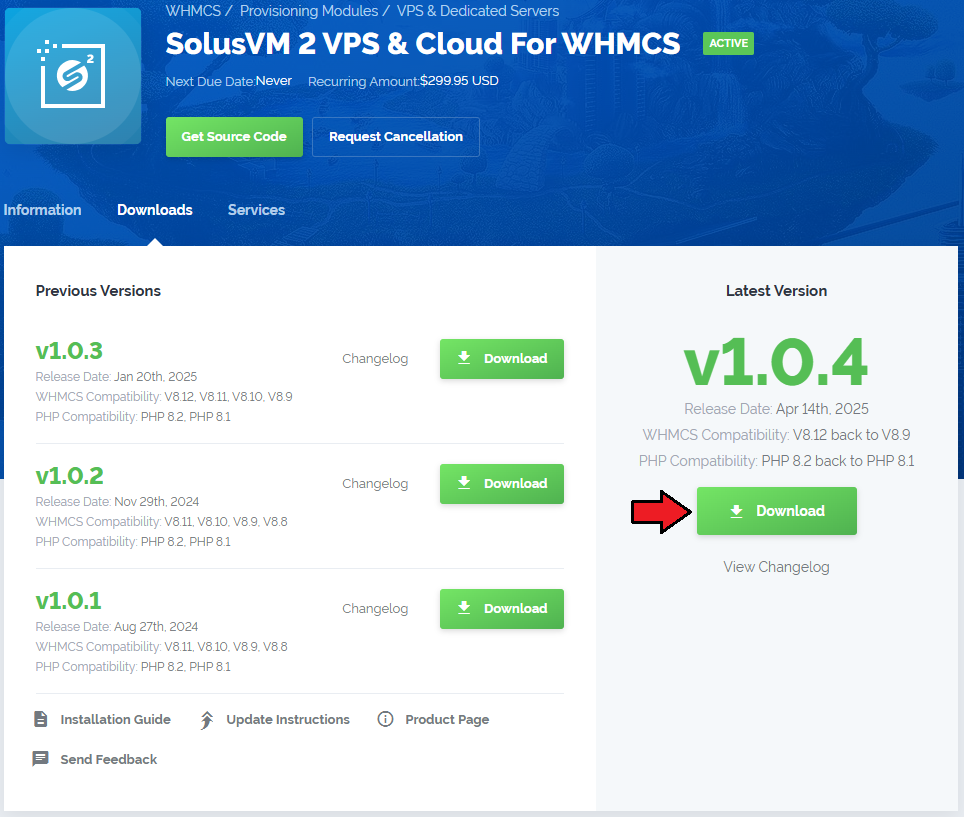
|
| 3. Extract the package and upload its content into the main WHMCS directory. The content of the package to upload should look like this. |
| 4. When you install SolusVM 2 VPS & Cloud For WHMCS for the first time you have to rename 'license_RENAME.php' file. File is located in '/modules/servers/SolusVM2VpsCloud/license_RENAME.php'. Rename it from 'license_RENAME.php' to 'license.php'. |
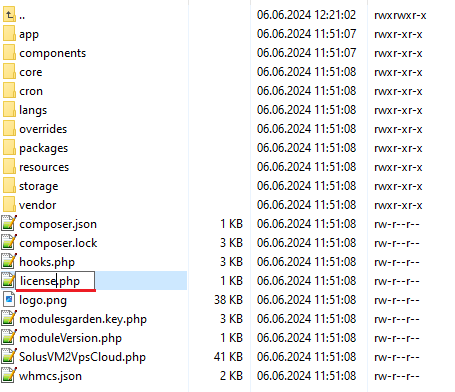
|
| 5. In order to configure your license key, you have to edit a previously renamed 'license.php' file. Enter your license key between quotation marks as presented on the following screen. You can find your license key in our client area → 'My Products'. |

|
| 6. In the next step, set up the 'storage' folder as recursively writable. This folder is available at 'your_whmcs/modules/servers/SolusVM2VpsCloud/storage'. |

|
[edit] Activation of SolusVM 2 VPS & Cloud Addon
| 7. Firstly, activate the SolusVM 2 VPS & Cloud addon. To do so, log in to your WHMCS and navigate to 'System Settings' →'Addon Modules'. Find 'SolusVM 2 VPS & Cloud' and press 'Activate'. |
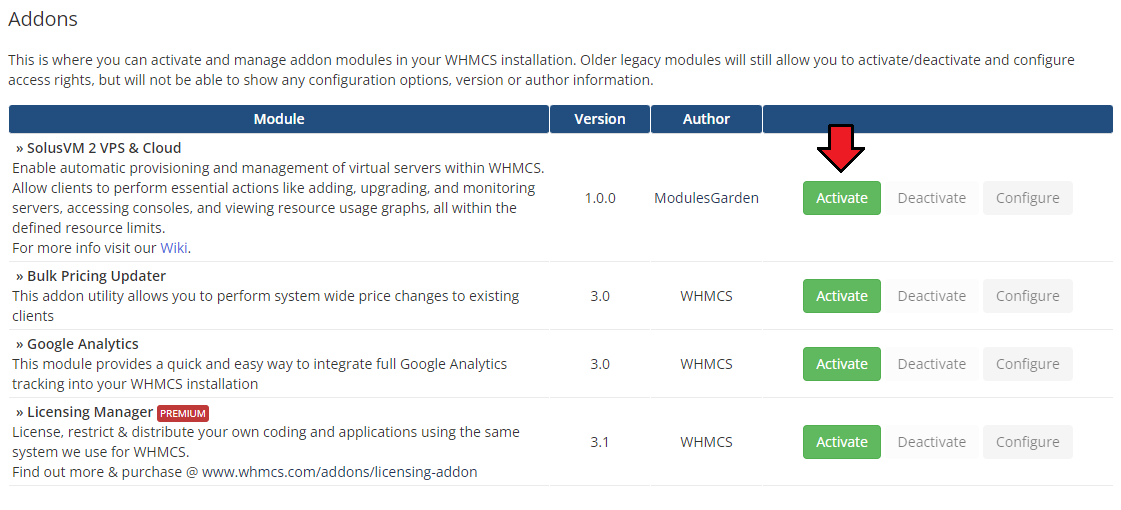
|
| 8. In the next step, you need to permit access to this module. To do so, click on the 'Configure' button, tick 'Full Administrator' and press 'Save Changes'. |
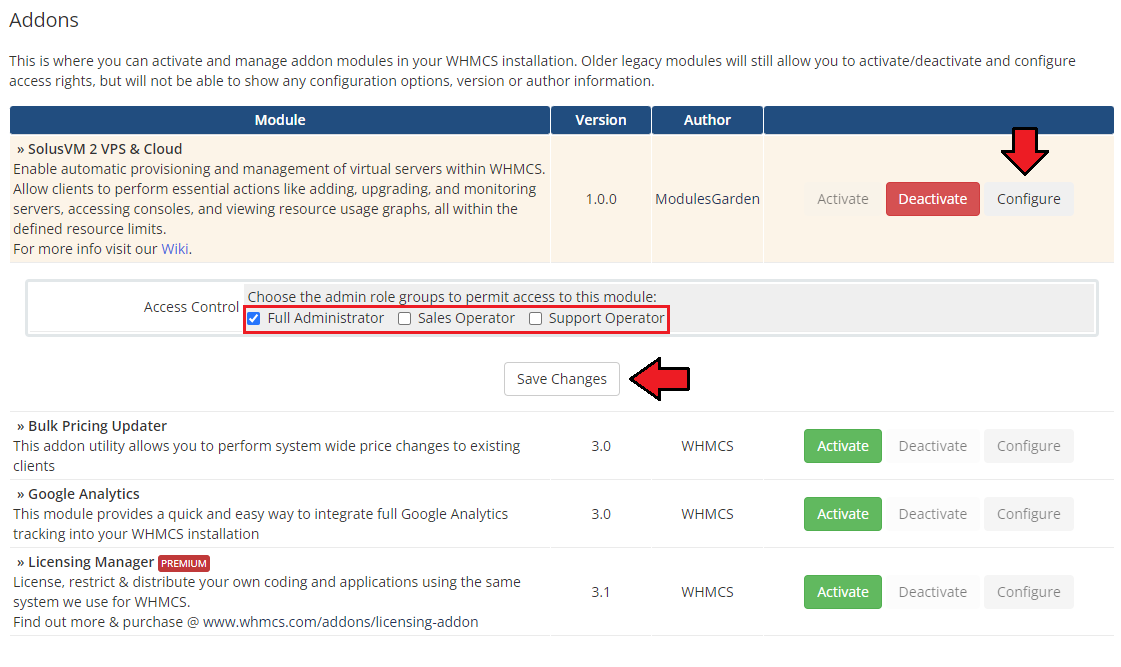
|
[edit] Configuration of Server
| 9. Now, log in to your WHMCS admin area and proceed to 'System Settings' → 'Servers'. Afterward, press 'Add New Server'. |
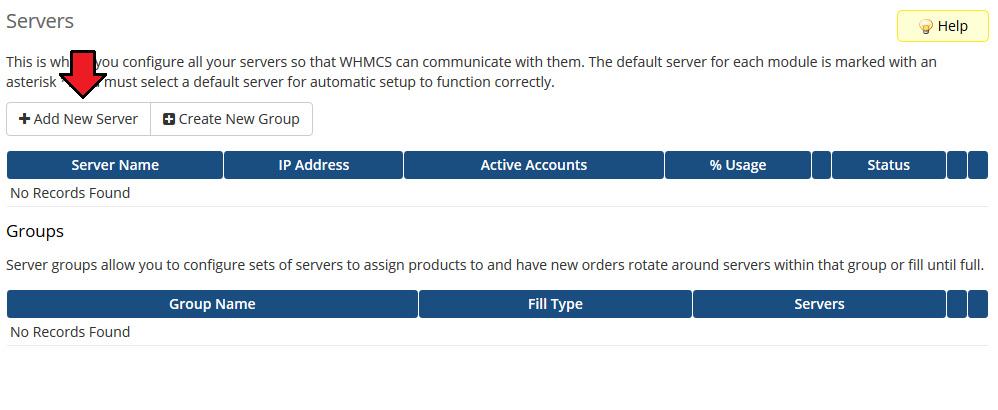
|
10. Enter your server name and IP address.
Check Secure option if your server uses an SSL connection. |
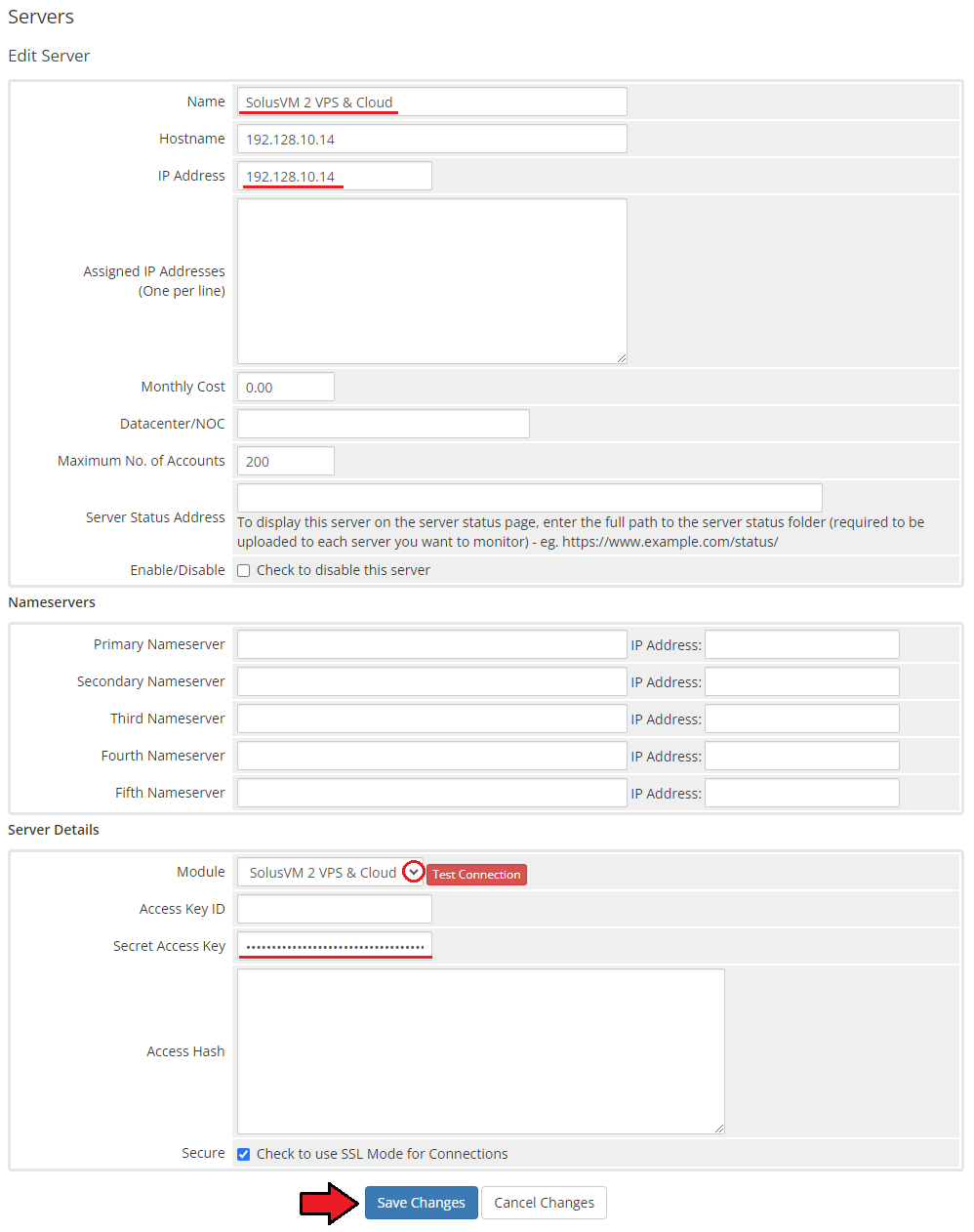
|
| 11. Now, you need to create a new group for your server. For that purpose press 'Create New Group'. |
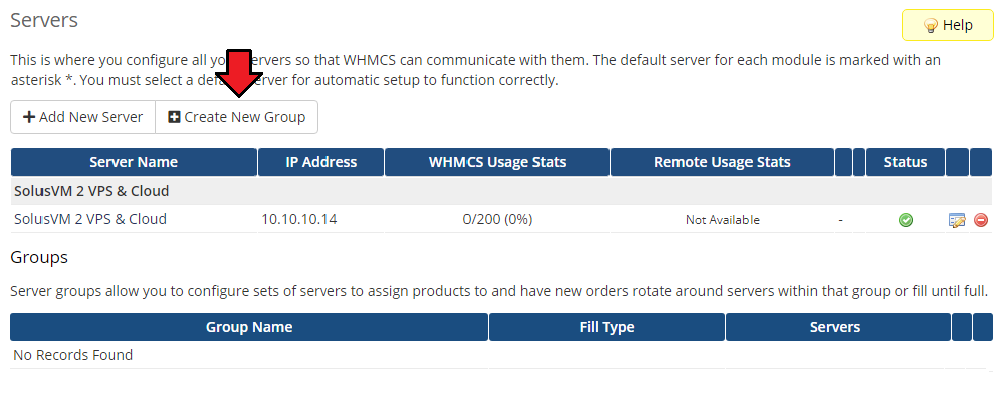
|
| 12. Fill in name, choose a previously created server and press 'Add'. Confirm by clicking on 'Save Changes'. |
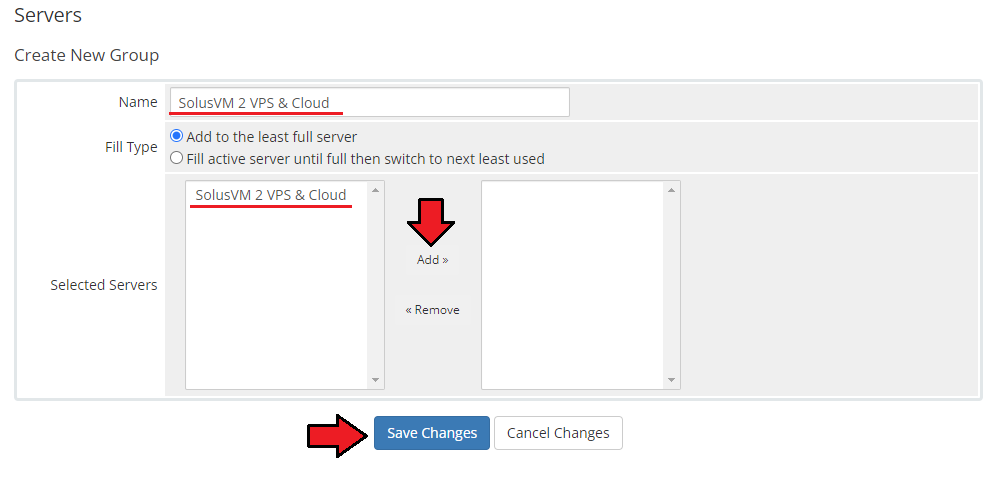
|
[edit] Configuration of Product
| 13. In order to create and configure product, go to 'System Settings' → 'Products/Services'. Afterwards, click on 'Create a New Group'. |

|
| 14. Fill in a product group name and press 'Save Changes'. |
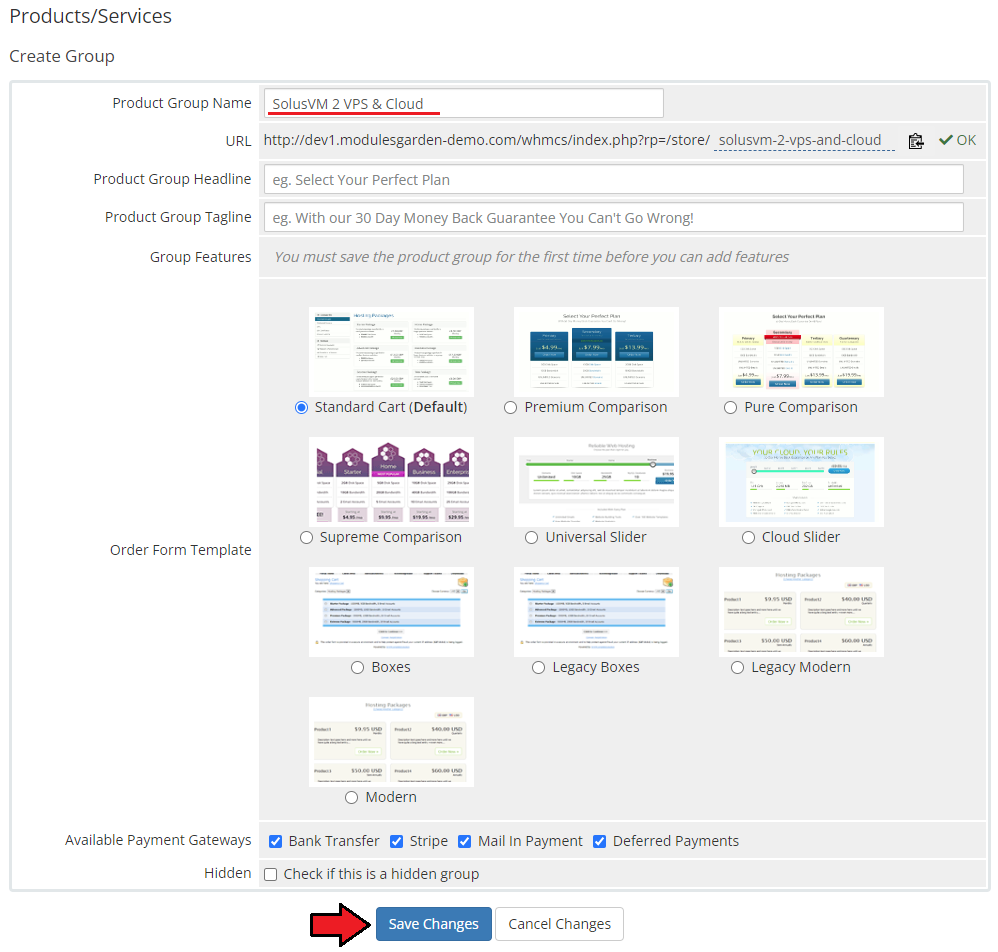
|
| 15. When you have a product group, you can create your product and assign it to SolusVM 2 VPS & Cloud. To create a product click on 'Create a New Product'. |
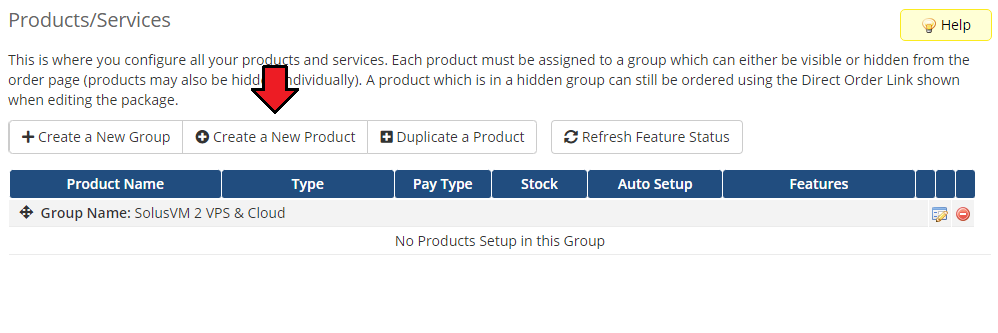
|
| 16. Afterward, choose your product type and product group from dropdown menus, fill in your product name and press 'Continue'. |
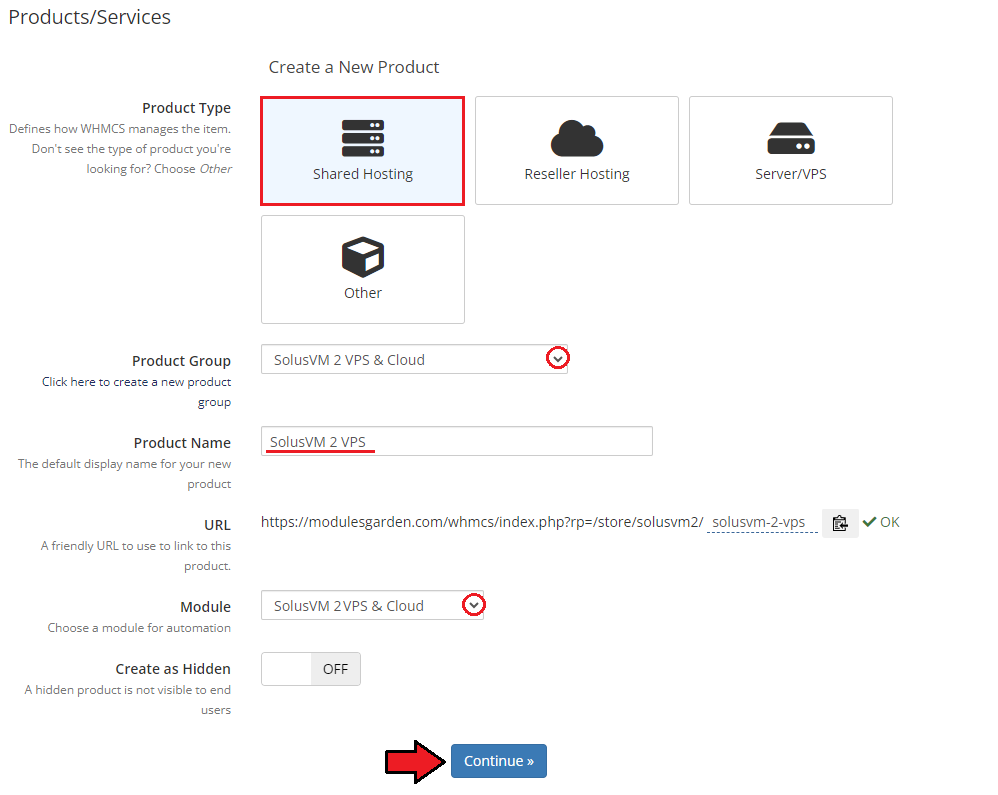
|
| 17. Now, go to 'Module Settings' section, and choose both 'SolusVM 2 VPS & Cloud' and a previously created server group from the dropdown menus. |
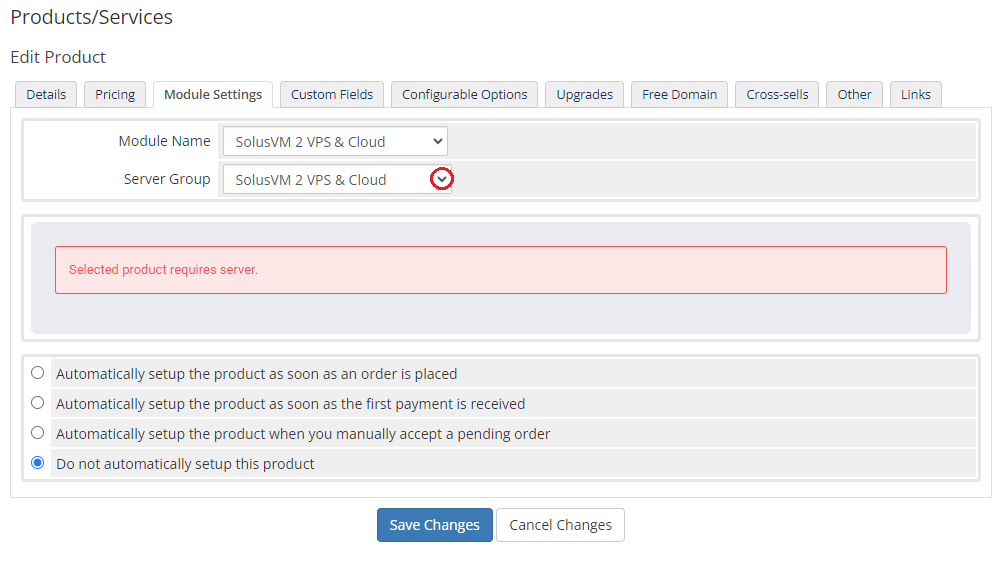
|
18. Start configuration of a product with the 'General' section.
|
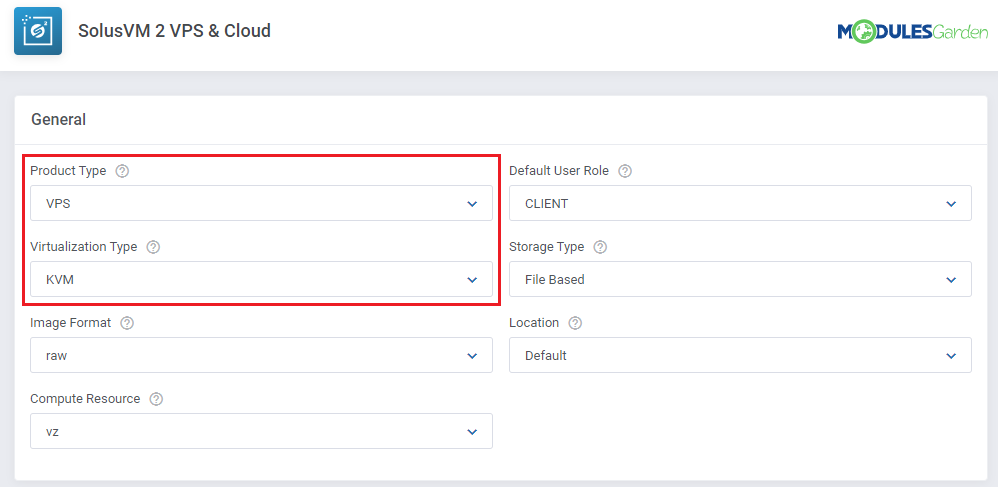
|
19. Now, choose the general settings.
|
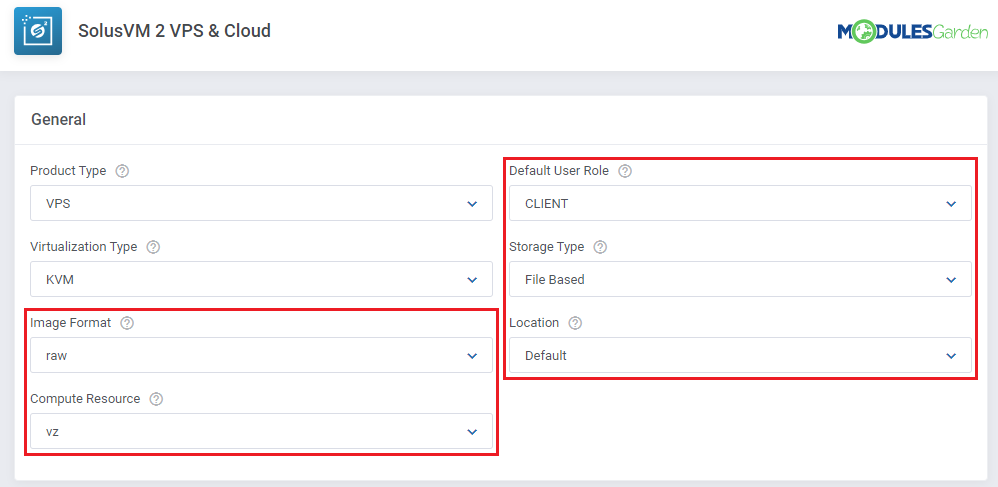
|
| 20. Set up the limits on the virtual machine. For both virtualization types, these are:
Additionally, for the VZ virtualization type define:
|
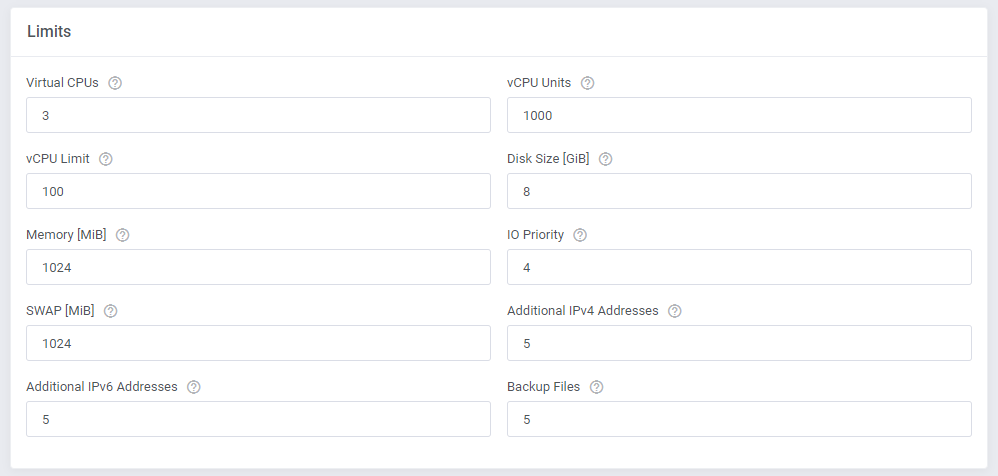
|
21. Define the default configuration.
|
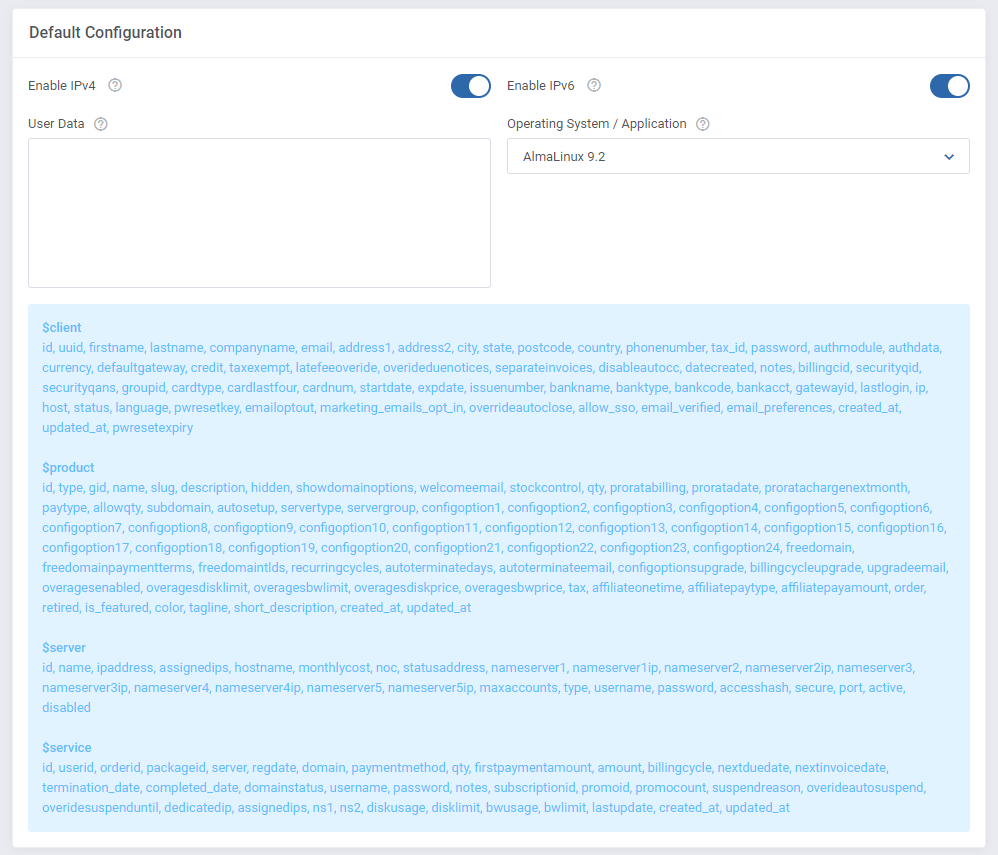
|
22. Configure service-related options.
Default Characters: abcdefghijklmnopqrstuvwxyzABCDEFGHIJKLMNOPQRSTUVWXYZ1234567890!@#$%^&*-_ |

|
| 23. Define features available in the client area by marking them in the 'Client Area Features' section. The functions that can be made available:
Images available for reinstallation:
|
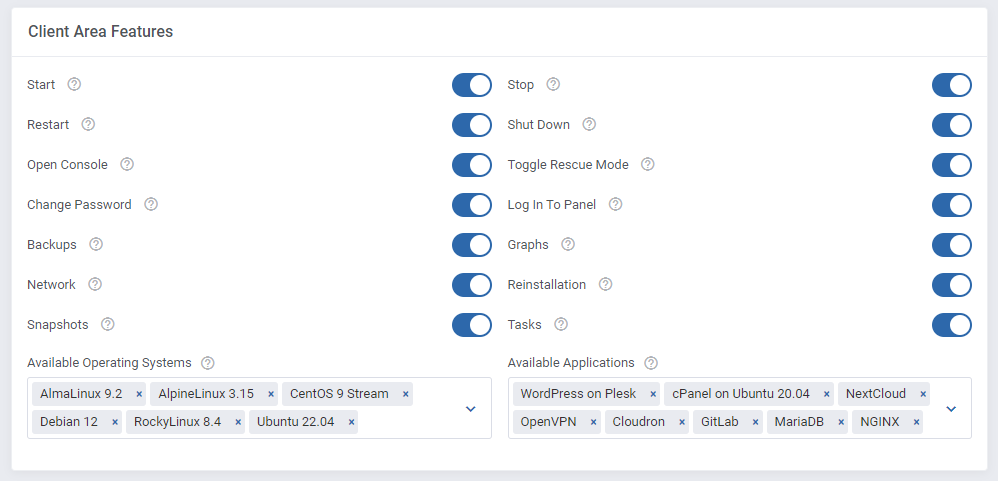
|
| 24. Generate default configurable options. To do so, press 'Generate' as shown on the screen below. You can choose which options to generate. Some options only work with virtual server [VS] virtualization type. |
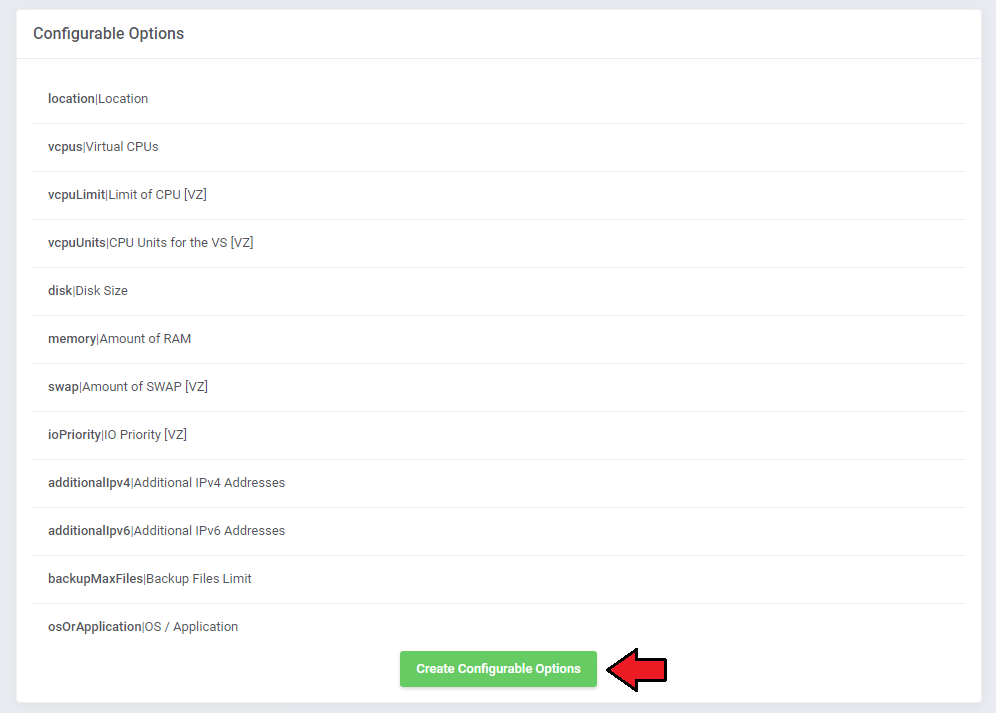
|
25. As the last step add a cron job as shown below (5-minute intervals are recommended).
php -q /your_whmcs/modules/servers/SolusVM2VpsCloud/cron/cron.php queue This cron makes sure tasks are run automatically when in the queue. |
[edit] Management
| You have just correctly created and customized a new product. Let us continue to the module management. The client area, the admin area and the addon will be described in detail in this section. |
[edit] Addon Configuration
| Now we will highlight the features of the addon first. Go to 'Addons' → 'SolusVM 2 VPS & Cloud' in your WHMCS to access it. |
[edit] Servers
| 'Servers' section contains a list of your configured servers, you may quickly edit them directly from this tab, simply press the edit icon. The information displayed in the addon includes:
|
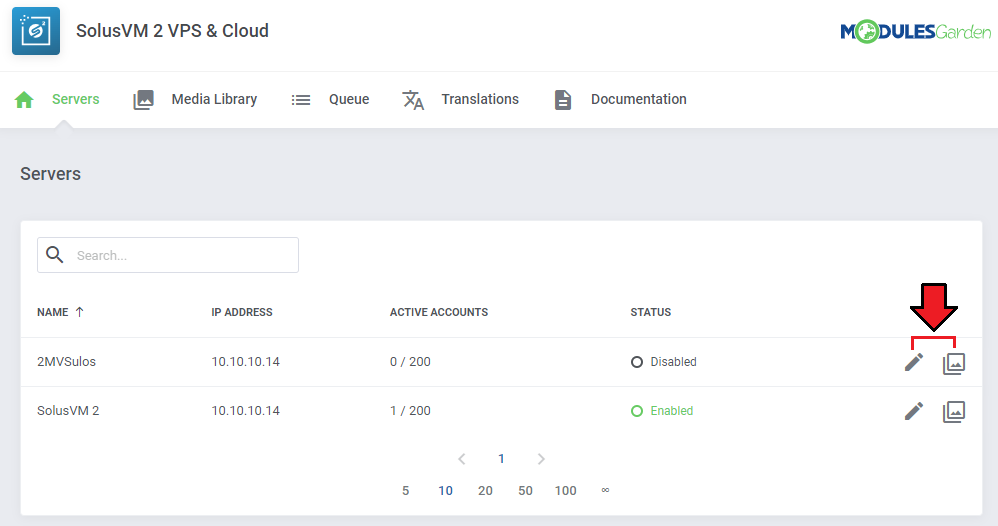
|
| Click on the 'OS Images & Applications Icons' button to view a list of images available on the server. You can change the image associated with each operating system and application by clicking the 'Settings' icon and choosing a picture from the media library. |
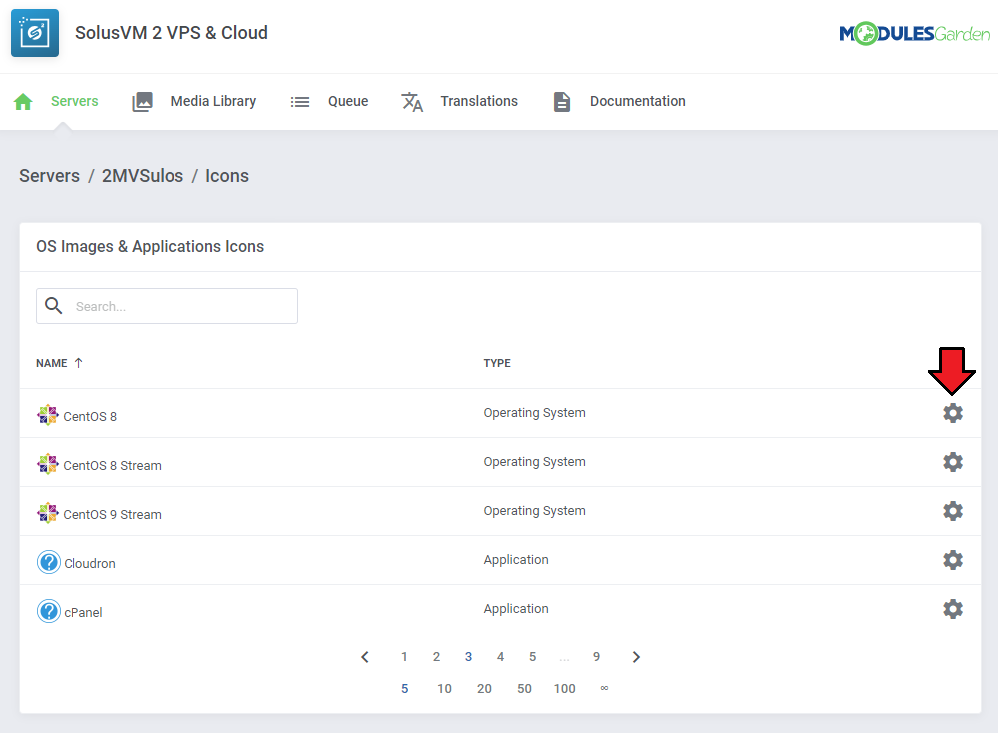
|
[edit] Media Library
| The 'Media Library' section stores images that can be used as thumbnails for your operating system and application images. Use the Additional Actions to delete all images at once. |
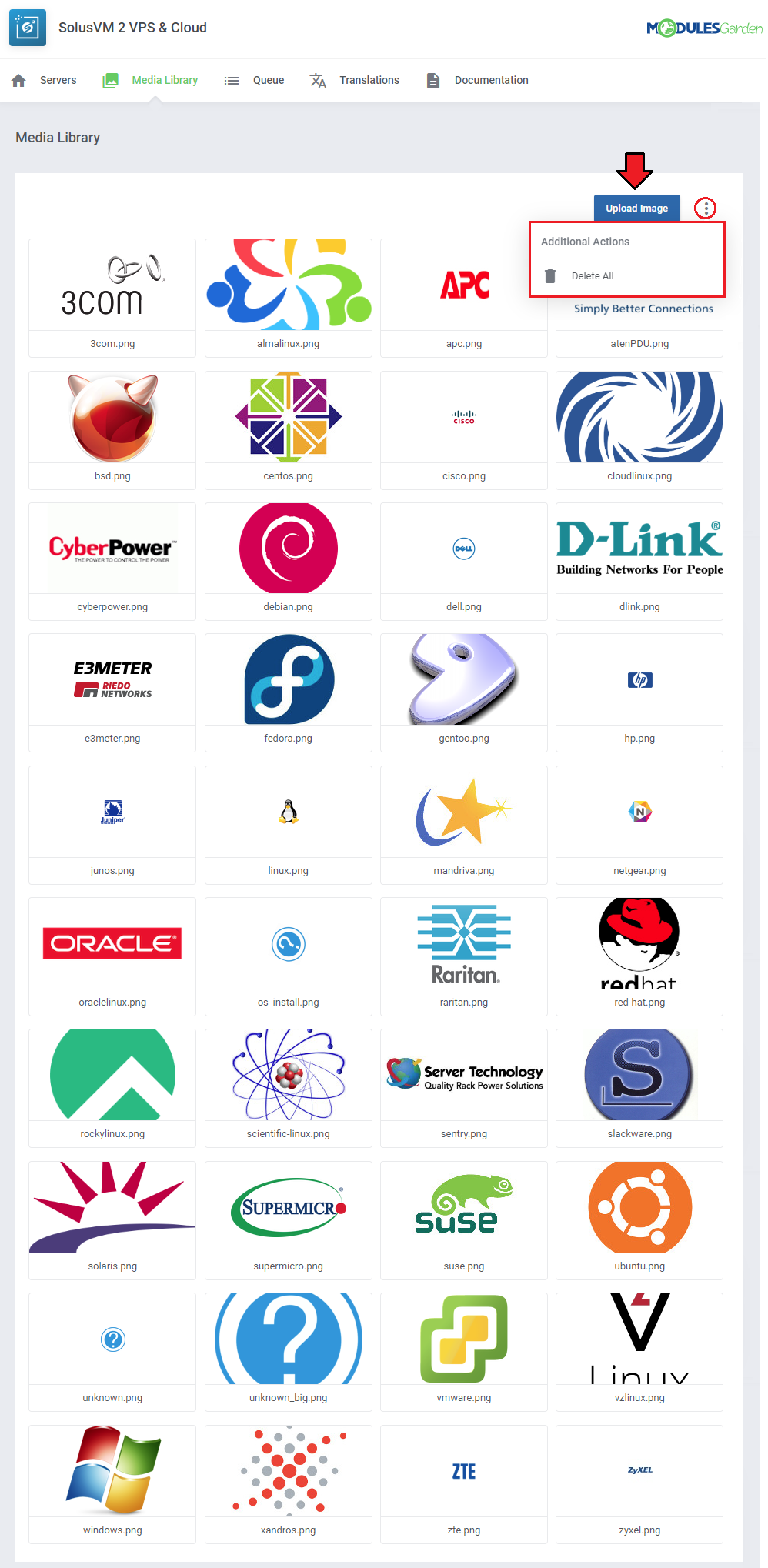
|
[edit] Queue
| In this section, you will find a list of all the tasks issued by the module. The information on each task includes:
You may also use the action buttons to:
To find specific tasks use the search and sorting functions. |
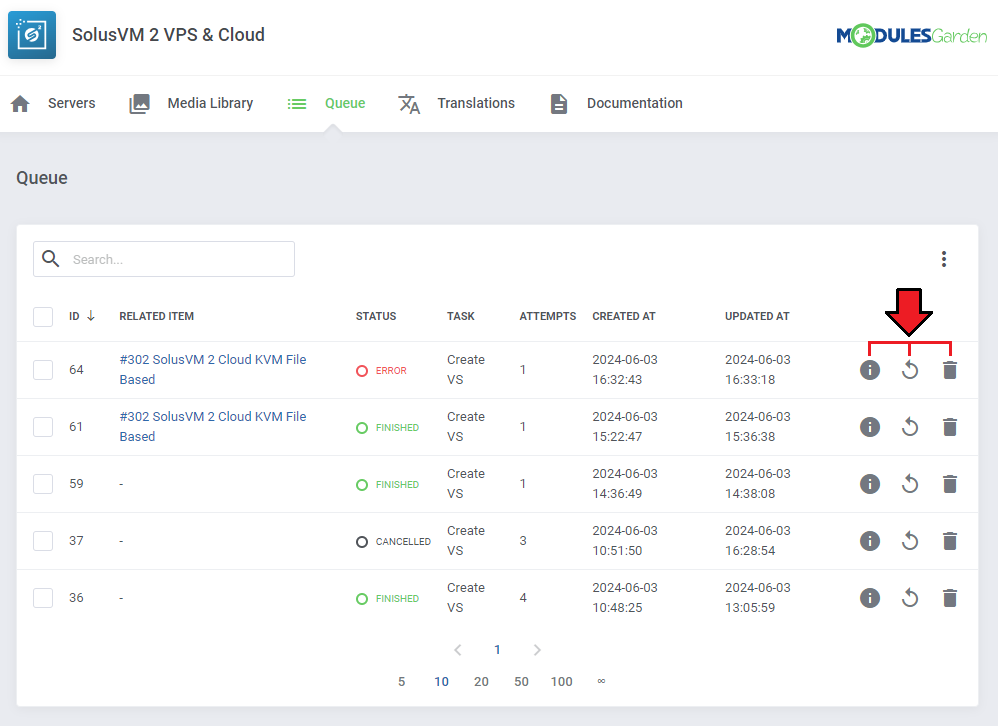
|
Task details include:
|
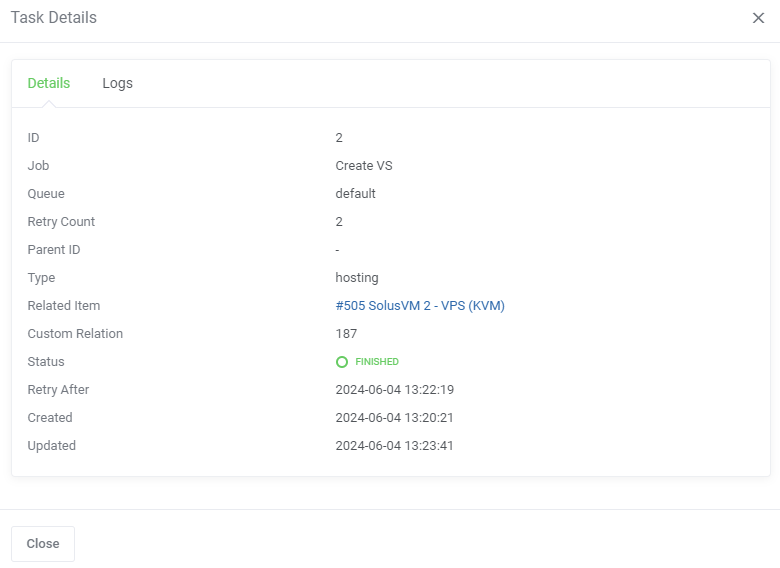
|
| Related log entries can be found in a separate tab. |
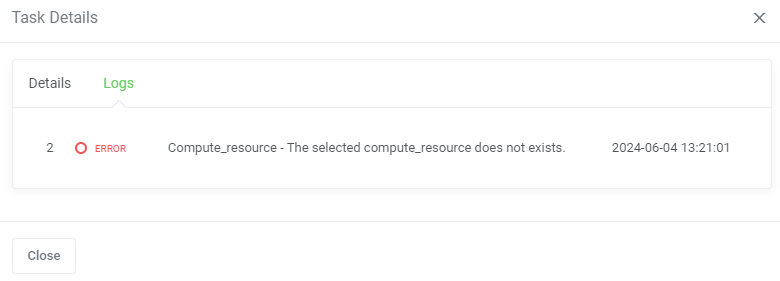
|
| Tasks can also be deleted with the mass action function. |
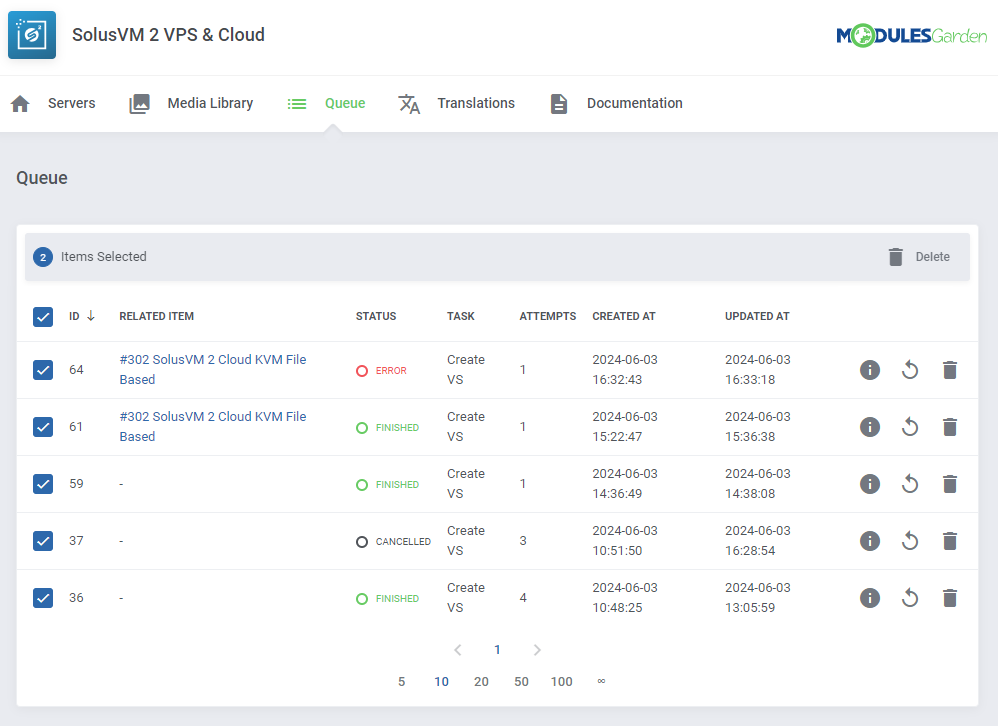
|
| Additional actions include the 'Auto Prune' system, which will automatically delete tasks after a predefined number of days and an option to disable cron job information. |
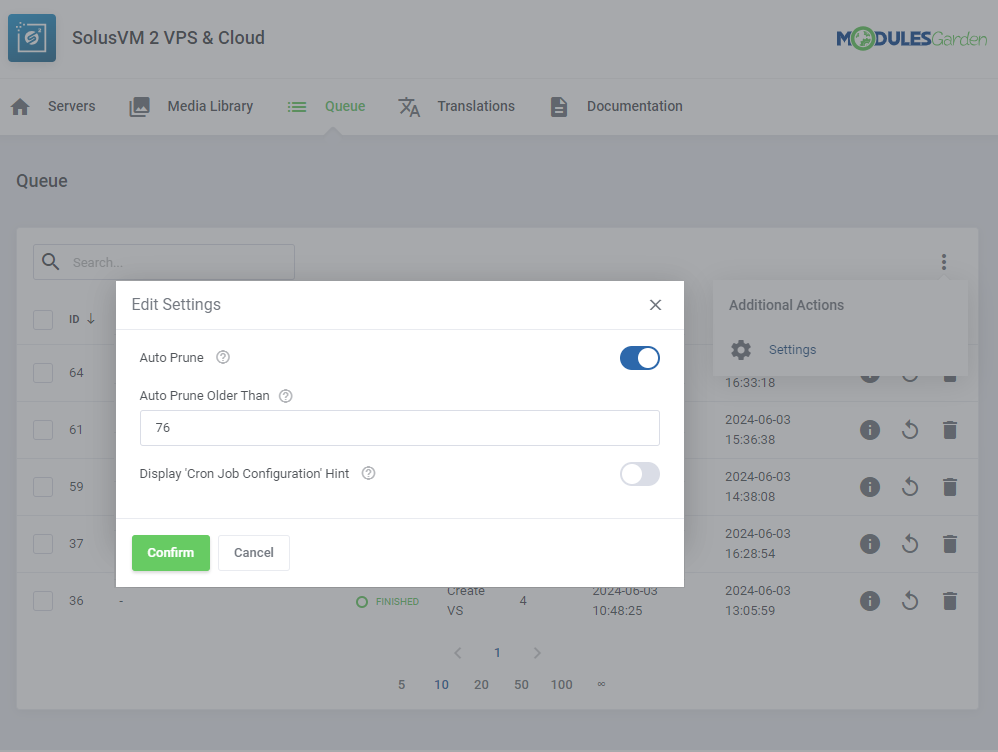
|
[edit] Translations
| Customizing language files is now extremely easy with the "Translations" tool that is now available directly in the addon. Its user-friendly design makes managing various language file tweaks a smooth and efficient process. Prepare translations for the original English files with this handy built-in tool. For specific instructions on how to use this tool please refer to its dedicated article, you will find it here. |
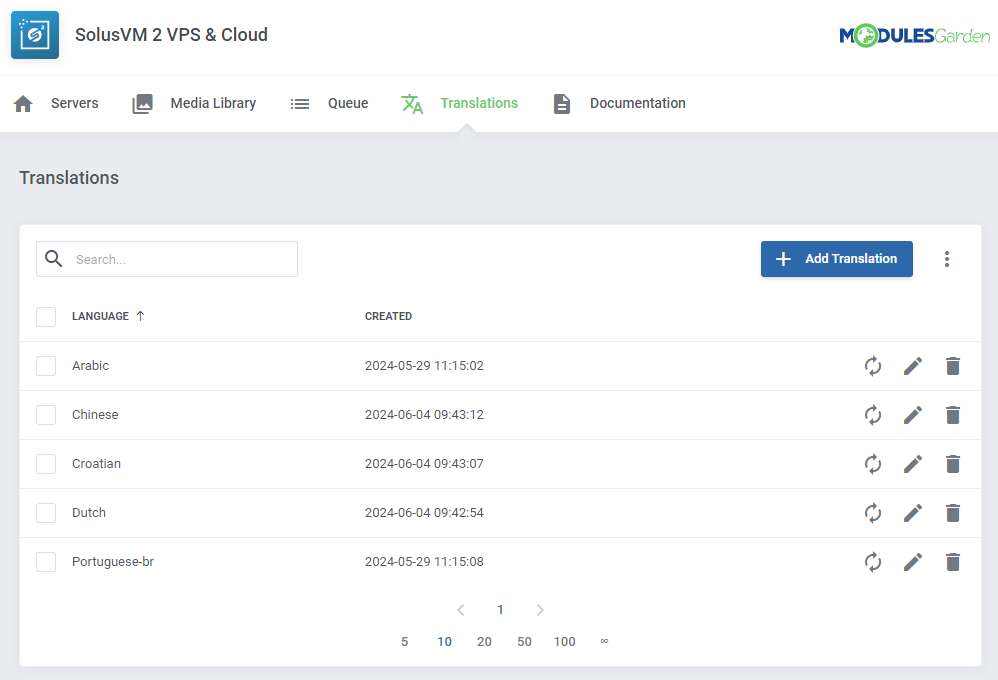
|
[edit] Admin Area
[edit] VPS
| Admins can monitor and manage the virtual machines on the client's page. The action buttons include:
Underneath the information regarding the virtual machine is located, it includes:
All tasks from the SolusVM 2 panel are logged in the 'Tasks' table. The 'Queue' table lists the tasks issued by the module. |
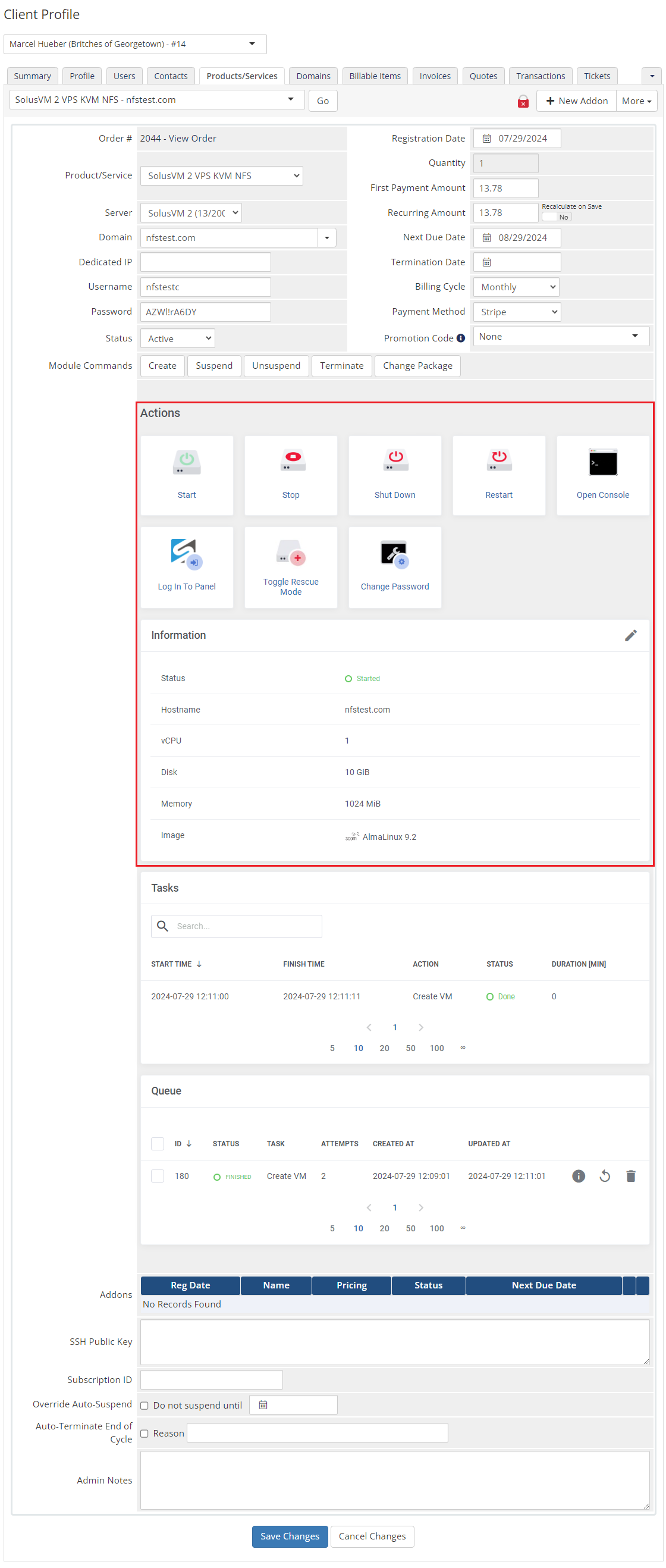
|
[edit] Cloud
| Admins can monitor and manage the machines on the client's page. The Available Resources graph displays how much of the distributed resources are in use.
and import new virtual machines. |
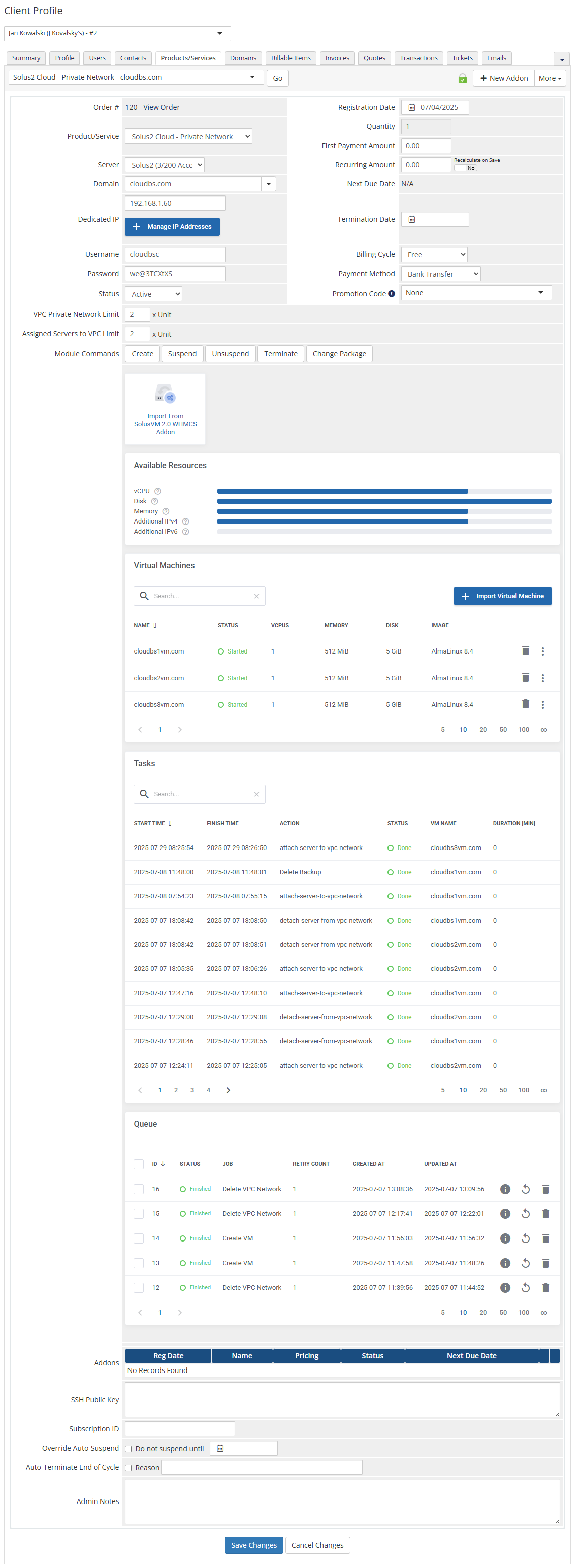
|
[edit] Client Area - VPS
| For the VPS products, clients have access to basic actions and information regarding their virtual machine. The basic actions include:
If enabled, additional tools will also be available to the user. |
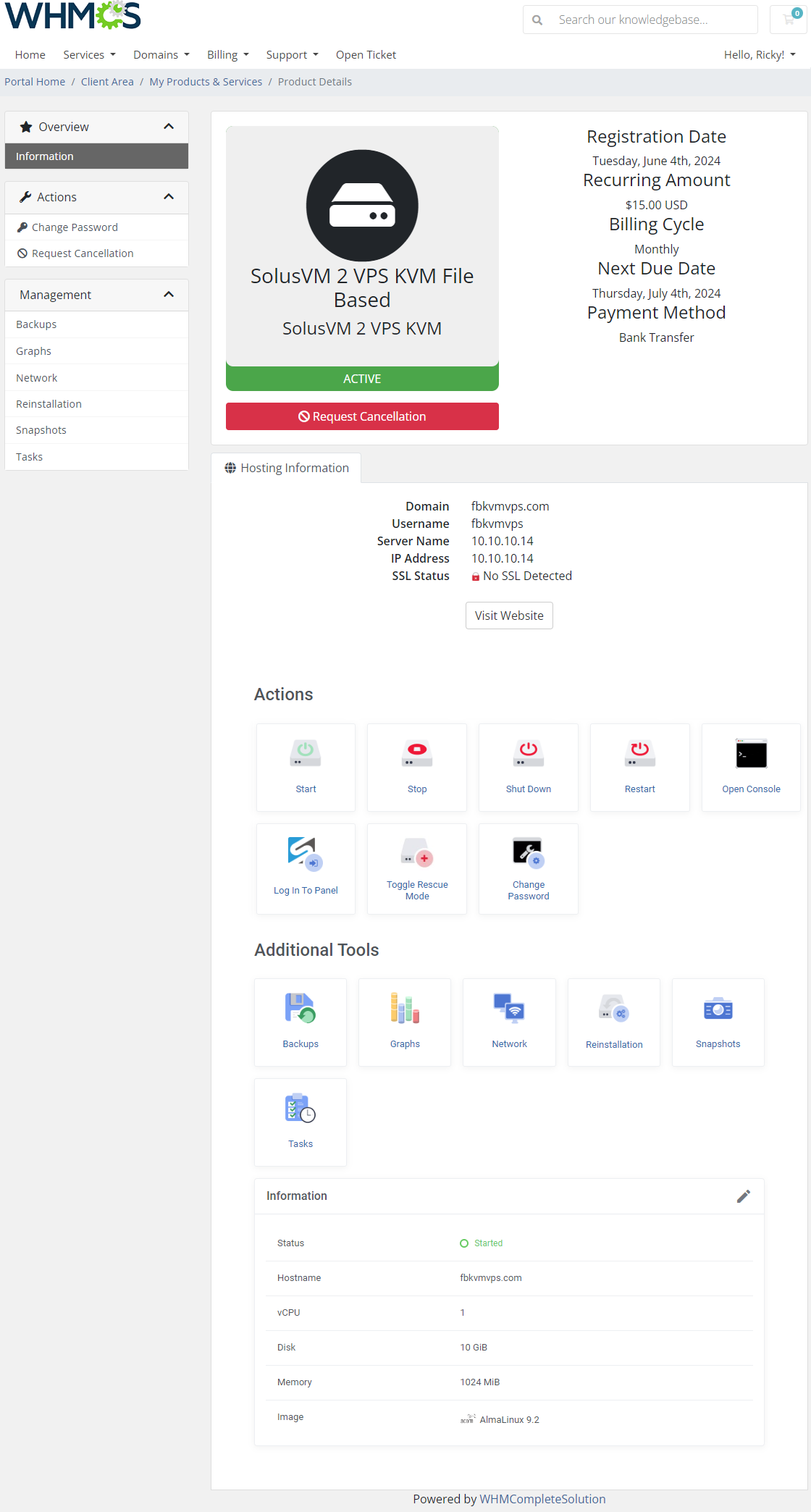
|
[edit] Backups
| Users can create and manage backups in the 'Backups' tab. To create a new backup use the 'Create Backup' button. |
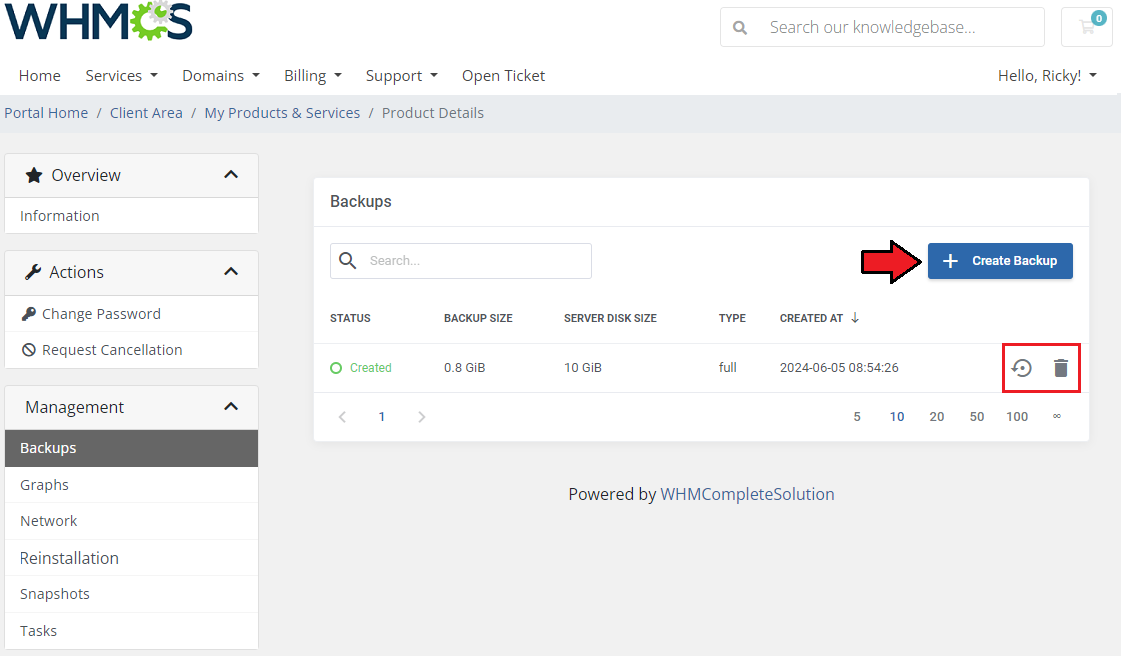
|
[edit] Graphs
| Clients will find visualizations of their current 'CPU Usage', 'Disk Throughput' , 'Network Throughput' and 'Memory Usage'. By tracking VPS usage sudden and unexpected overloads can be avoided. |
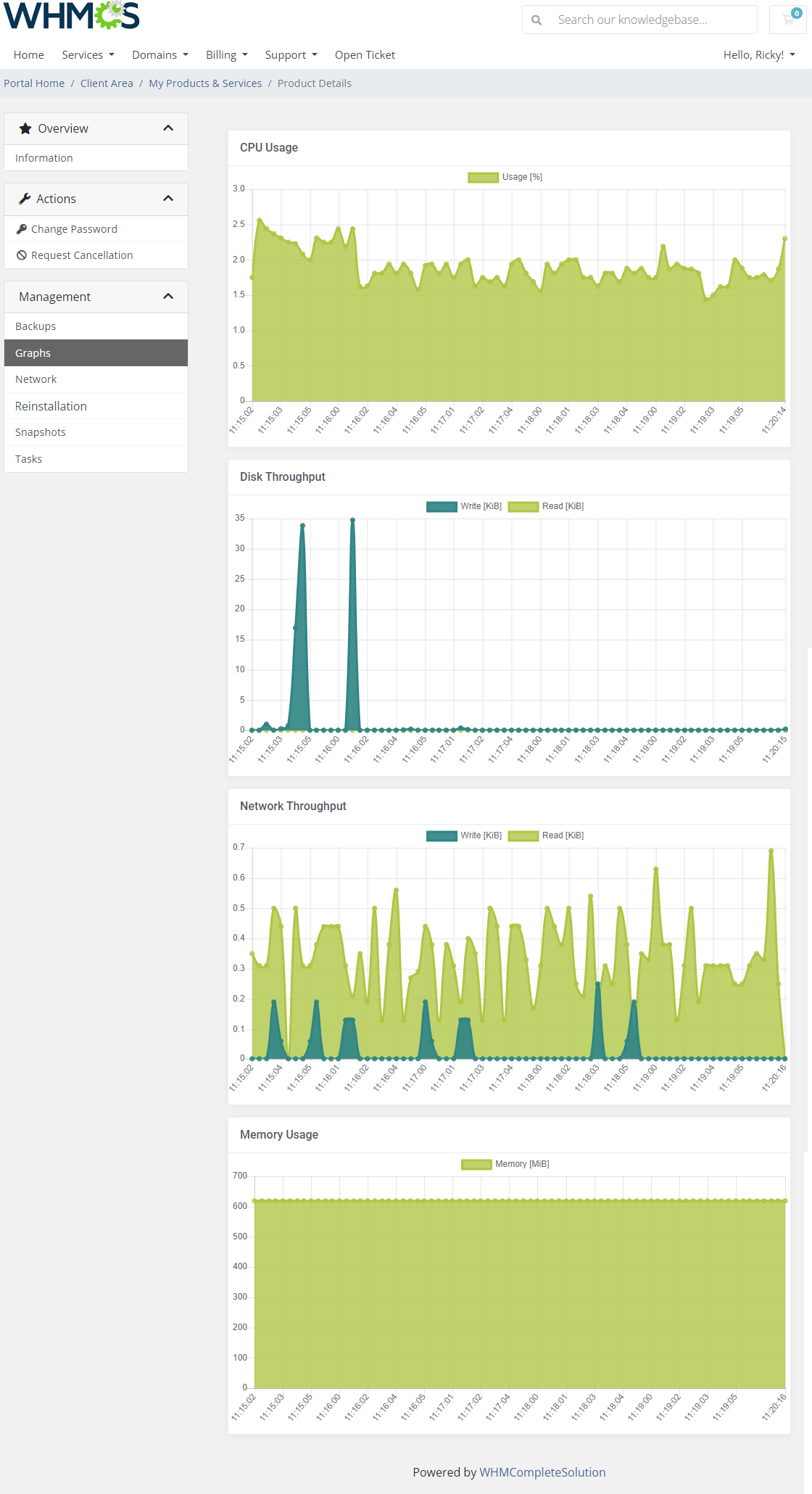
|
[edit] Network
The network tab contains information regarding the virtual machine's network settings.
and whether a given network is set as a primary for the virtual machine. |
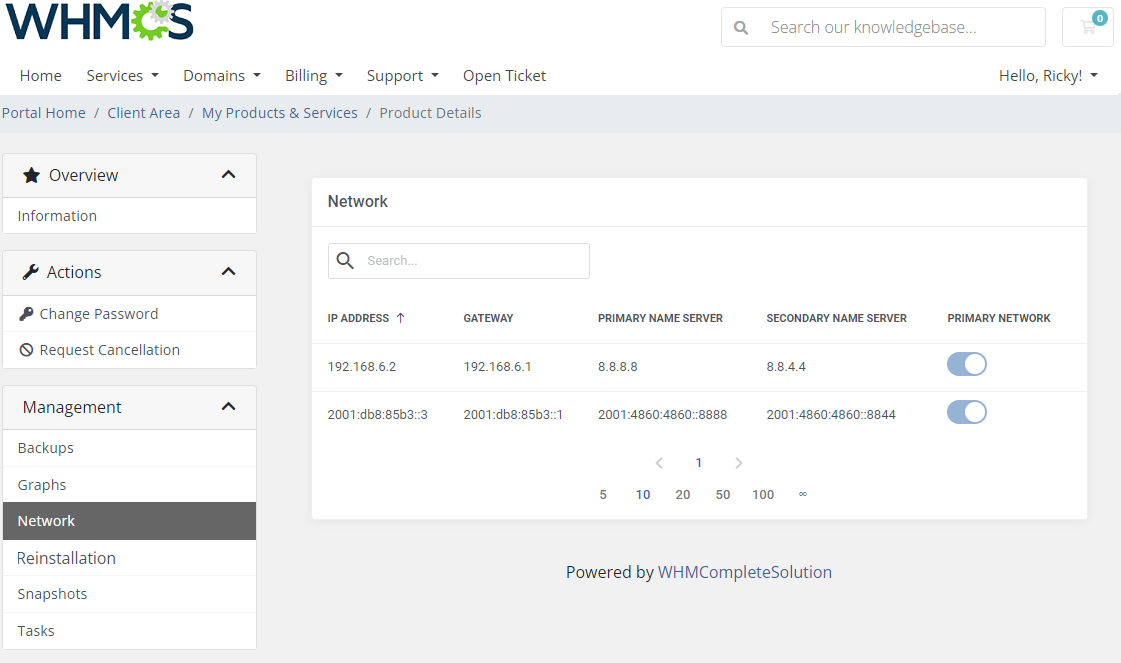
|
[edit] Reinstallation
| The 'Reinstall' tab contains a list of operating systems and applications allowed for virtual machine reinstallation. Clicking on any of the icons will initiate the reinstallation process, after a confirmation popup. |
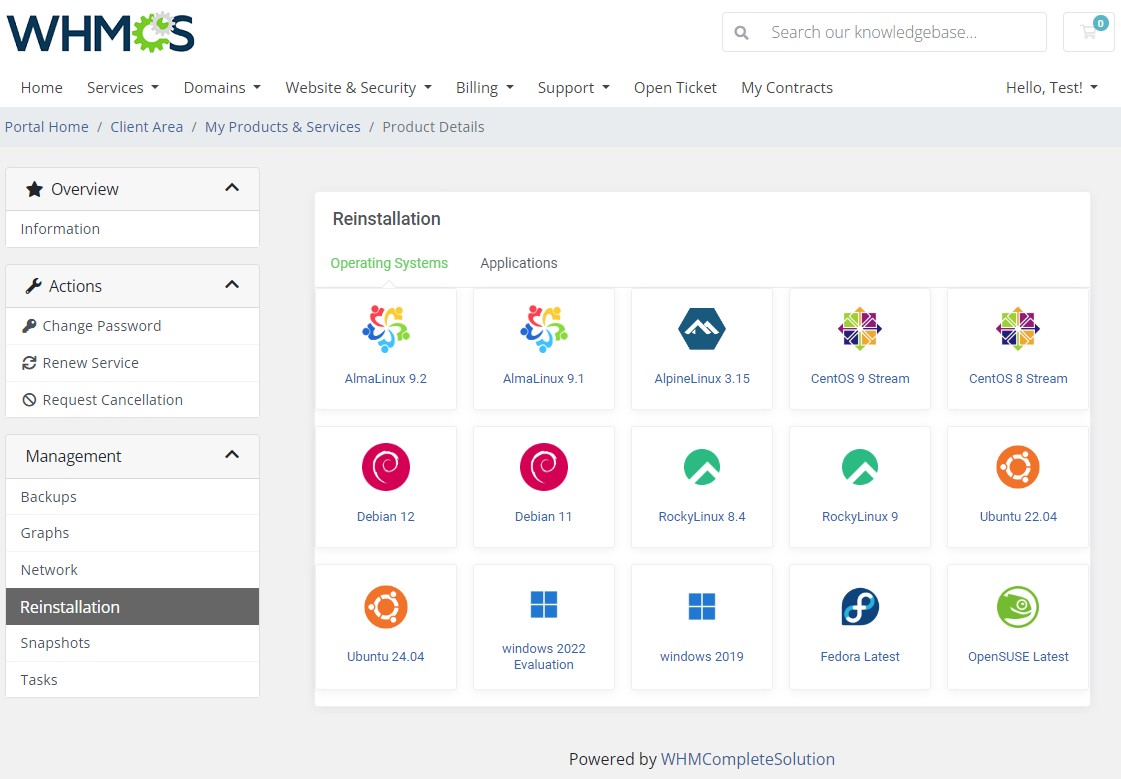
|
[edit] Snapshots
| The 'Snapshot' tab allows the users to create new snapshots and manage their snapshot library. Use the 'Create Snapshot' button to take a new snapshot. |
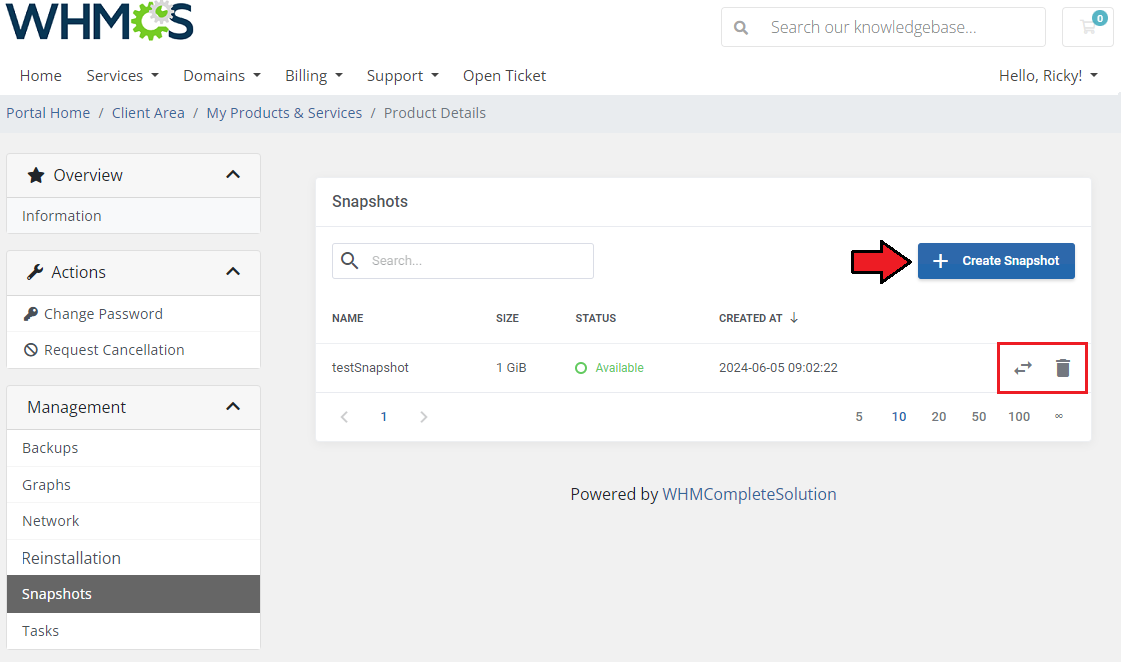
|
[edit] Tasks
| The list of tasks related to the client's virtual machine can be found in the 'Tasks' tab. The list features details such as:
|
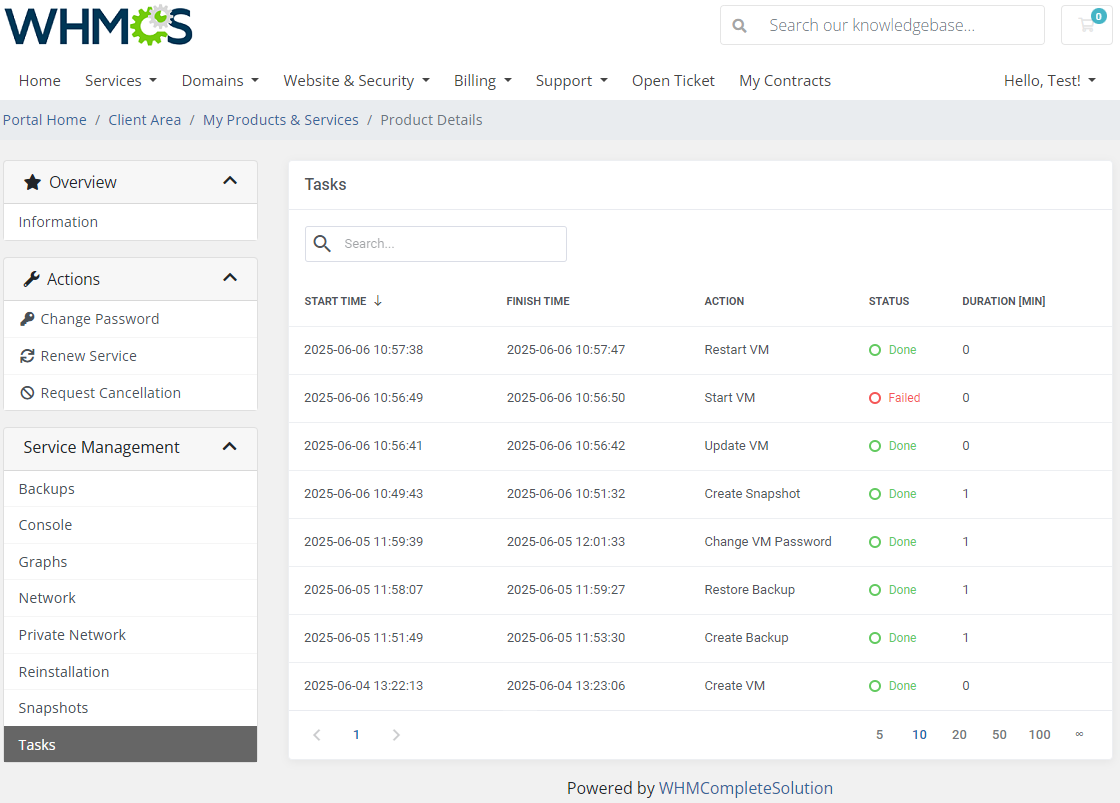
|
[edit] Client Area - Cloud Type
| The client area of cloud products features 'Available Resources' information table and the 'Virtual Servers' list. The table features a graphical representation of the resource usage of
Hovering over the question mark icon will display the exact numbers for each metric. |
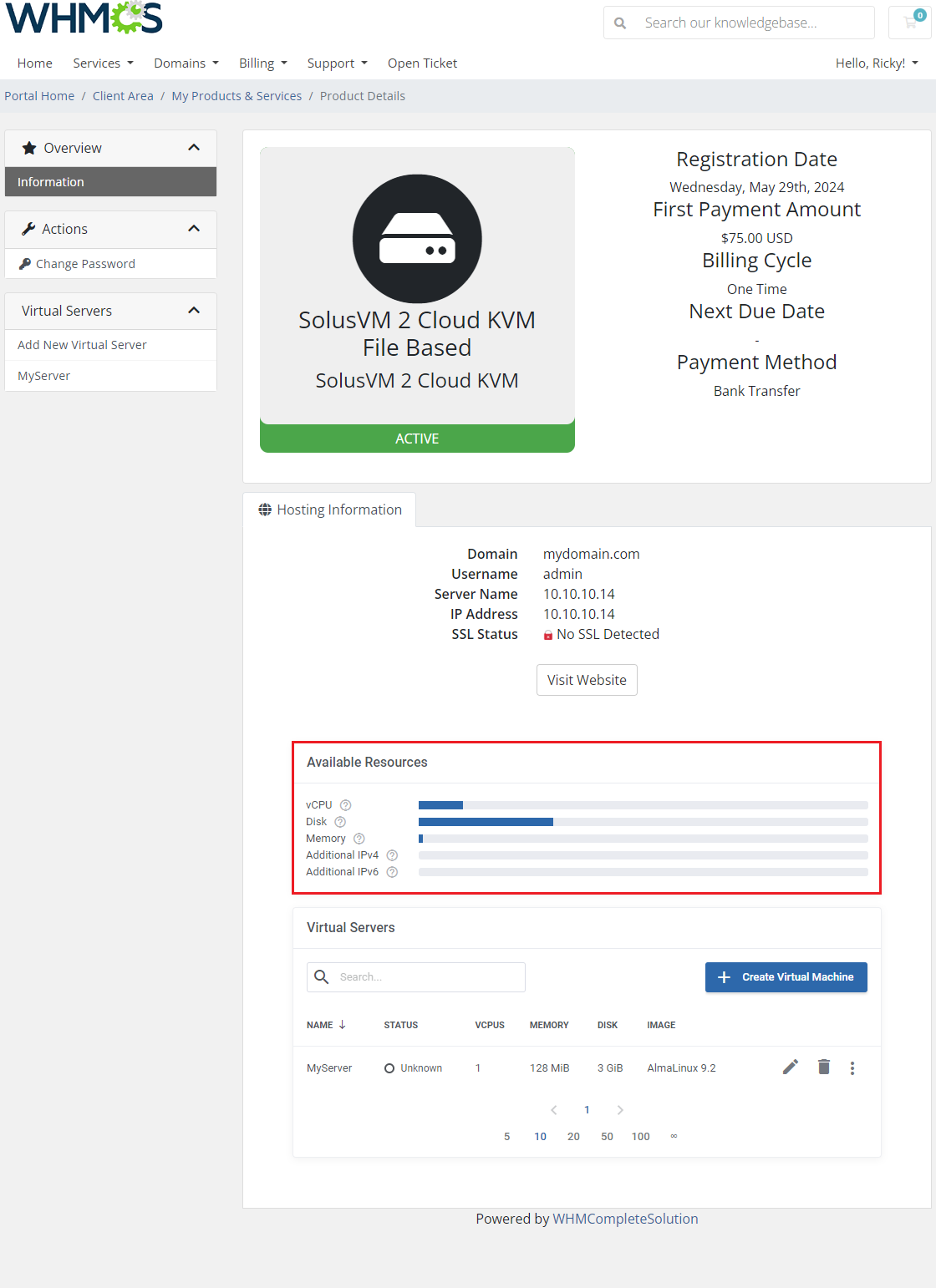
|
Action buttons allow managing, deleting, and performing actions on existing servers.
|
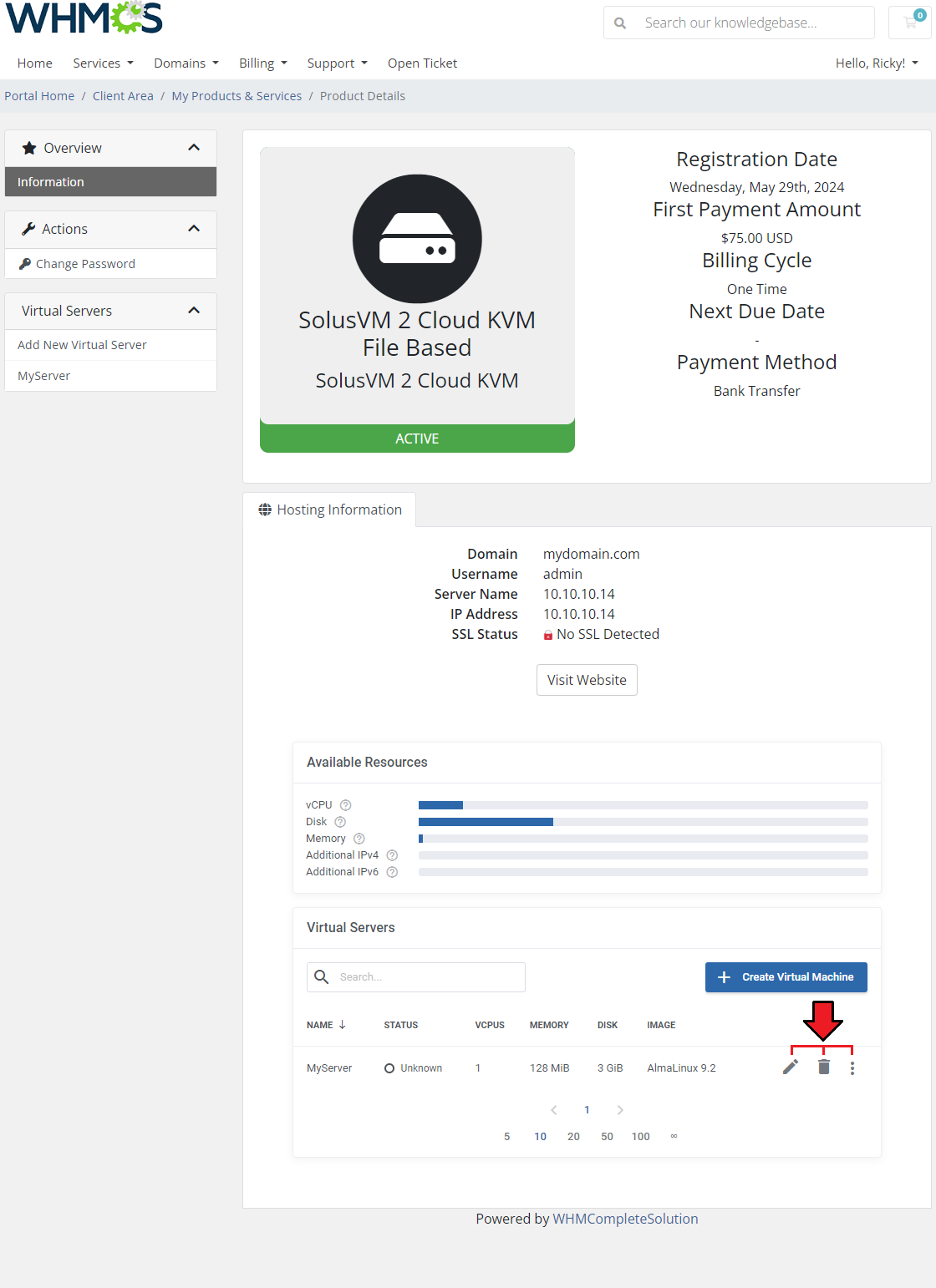
|
[edit] New Virtual Machine
|
To add a new virtual machine, click on the 'Create Virtual Machine' button first. |
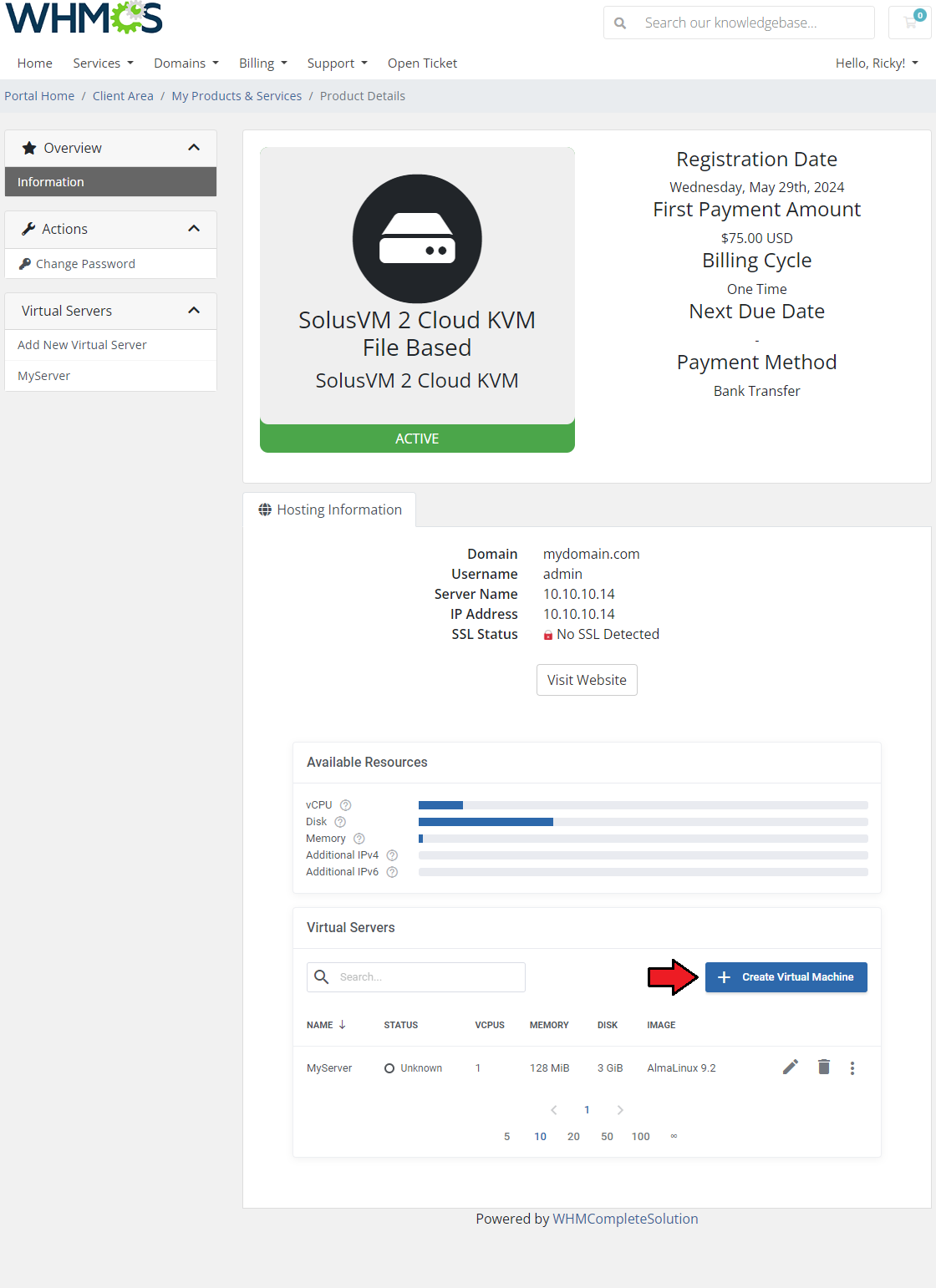
|
Then provide the configuration for the new virtual machine.
The graph on the top of the screen can help you see how many resources remain while you allocate them to the new machine. |
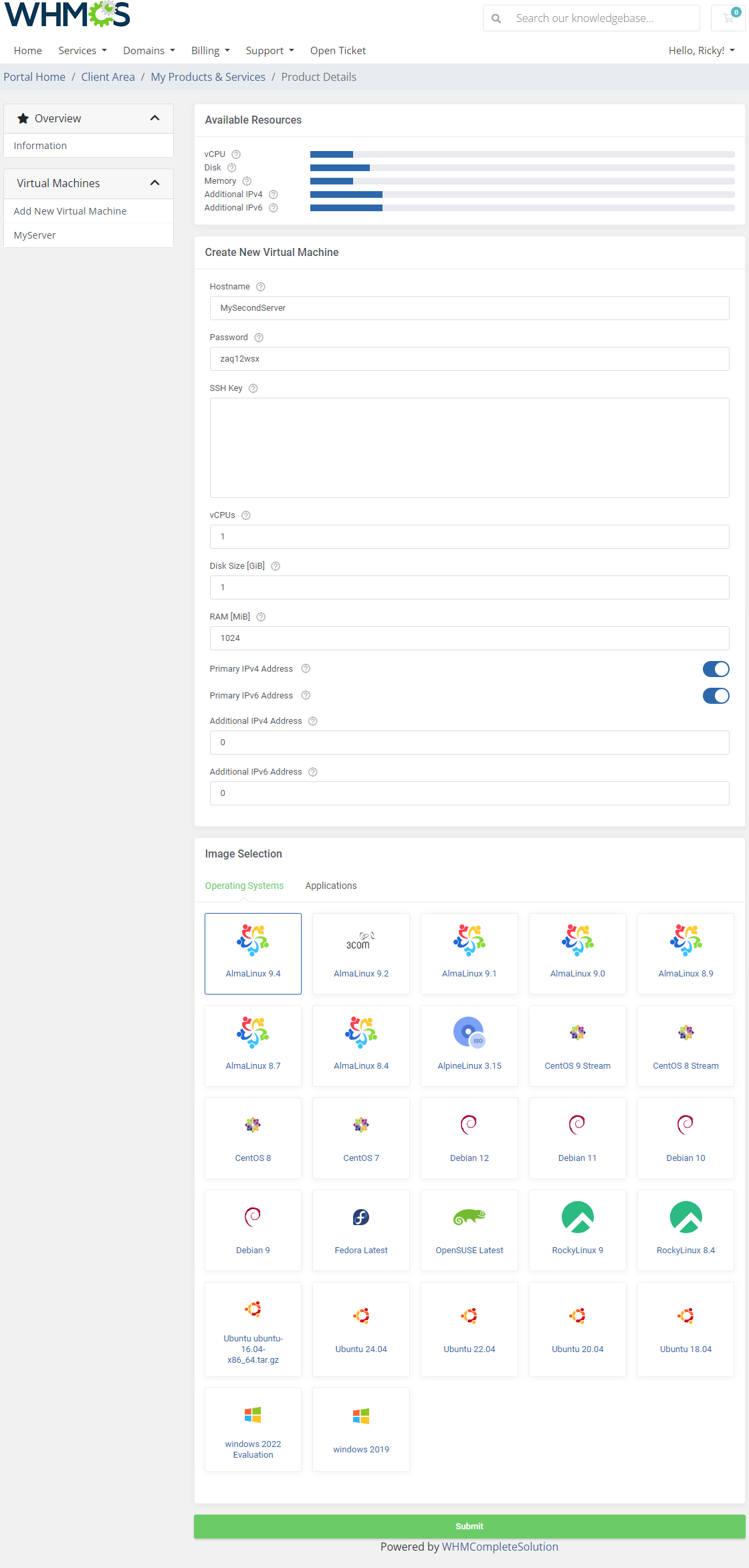
|
| You can also manage a machine directly and use additional tools, after selecting it on the side menu. |
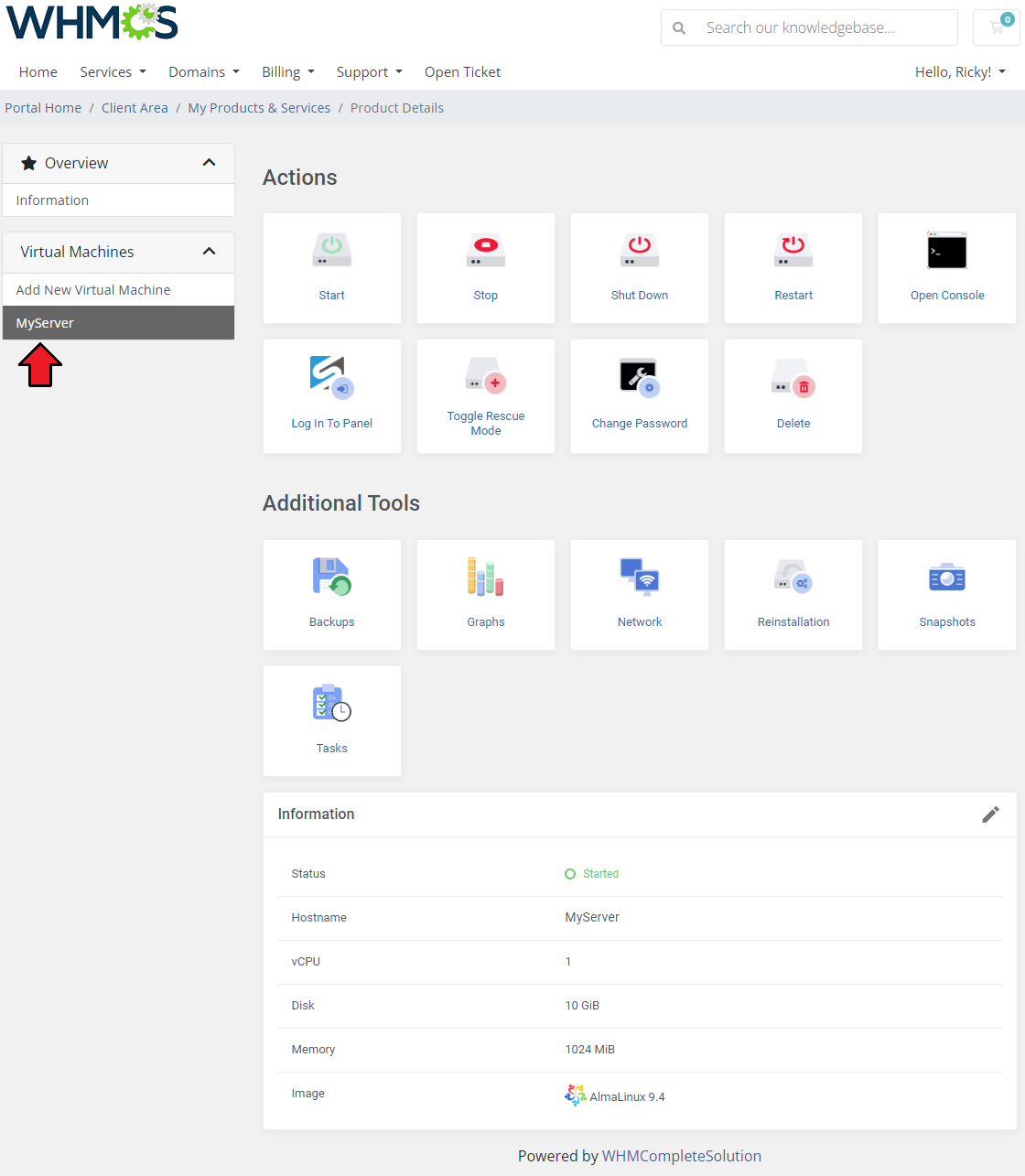
|
| 1. Since the SolusVM 2 panel only allows a small number of special signs to be used in passwords, it might be helpful to disable special characters in auto-generated passwords. To do so, navigate to 'General Settings' → 'Security' → 'Auto Generated Password Format' and select 'Generate passwords containing a combination of letters and numbers only'. |
2. You can add an SSH Key for a virtual machine using a sshKey|SSH Public Key custom field for the VPS functionality. For the Cloud functionality, the option to add an SSH Key is available when creating a new virtual machine. |
| 3. SolusVM 2 VPS & Cloud module can manage virtual machines imported from SolusVM 2.0 WHMCS addon. To import your machines use the 'Import From SolusVM 2.0 WHMCS Addon' button found in the admin area. For VPS products this option is available after service has been activated, but the machine has not been created yet. |
[edit] Update Instructions
| An essential guidance through the process of updating the module is offered here. Ensure successful completion of the module update by carefully following each step, thereby preventing data loss or any unforeseen issues. |
[edit] Upgrade Guide
| Seeking a solution that offers greater flexibility, customization tailored to your precise needs, and unrestricted availability? There is an option that not only proves to be cost-effective in the long run but also includes prioritized support services, making it a truly valuable investment. Opt for the Open Source version of your SolusVM 2 VPS & Cloud For WHMCS module to unlock these benefits. Follow a comprehensive guide covering the transition process, the advantages it brings, and step-by-step instructions on what to do next after the order has been successfully finalized. |
[edit] Common Problems
| 1. When you have problems with connection, check whether your SELinux or firewall does not block ports. |